A publication of Intuit: The Center for Intuitive and Outsider Art

Volume 26 | Winter 2021/2022

2 THE OUTSIDER Sound x Design Opening November 13, 2021 > 72 E Randolph St., Chicago, 60601 > designchicago.org > @designmuseumchi
ABOUT INTUIT:
Founded in 1991, Intuit is a premier museum of outsider and self-taught art, works created by artists who didn’t, or sometimes couldn’t, follow a traditional path of art making, using materials at hand to realize their artistic vision.
INDEX
Letter from the President by
debR a keRR
Comics of the Day Influenced Darger's Artworks by
michaeL bonesteeL
Some Thoughts on the Recent Past and Future of Outsider and Self-Taught Art Rundquist
Walking in Beauty
Building a Pipeline of Future Museum Professionals
by Lindsey wuRz featuRing cieLo aguiLeR a
by wiLLiam swisLow book reviews by wiLLiam swisLow leadership support contributors
Cover: Henry Darger (American, 1892–1973). 205 While inside they await developments (detail), c. 1950-60. Mixed media, dimensions unknown. Collection of Audrey B. Heckler. Photograph © 2021 Visko Hatfield. © 2022 Kiyoko Lerner / Artists Rights Society (ARS), New York
Above: Sculpture by Roman Villarreal. Photograph by William Swislow. ISBN 978-0-9990010-3-5
The Outsider is published once a year by Intuit: The Center for Intuitive and Outsider Art, located at 756 N. Milwaukee Avenue, Chicago, IL 60642. Prior to Fall 1996, Volume 1, Issue 1, The Outsider was published as In'tuit.
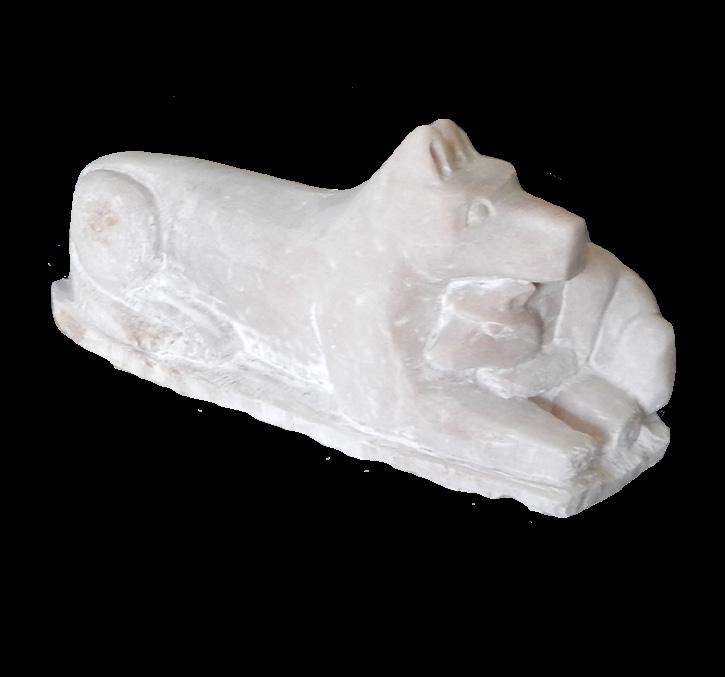
05 06 14 20 32 41 42 28
Photographs from the Henry Darger Room and the accompanying exhibition series Henry Darger: The Room Revealed, in which curators Alison Amick, Michael Bonesteel, Leisa Rundquist and Mary Trent explored questions about Darger's life and work by studying the objects, tracings and writings in his collection. Upon the conclusion of the series, Intuit temporarily de-installed the Henry Darger Room in its entirety (demonstrated in the photograph to the immediate left of the text box) for conservation.
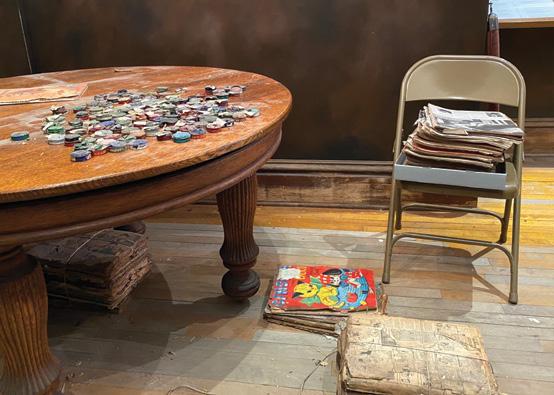
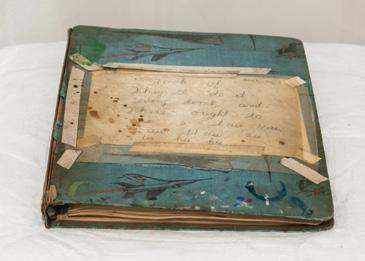
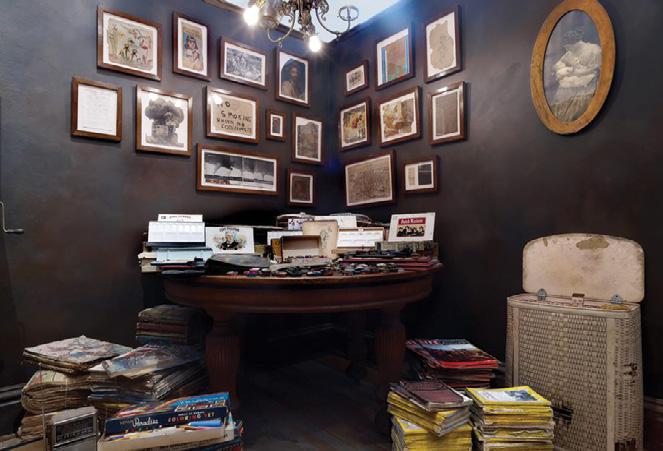
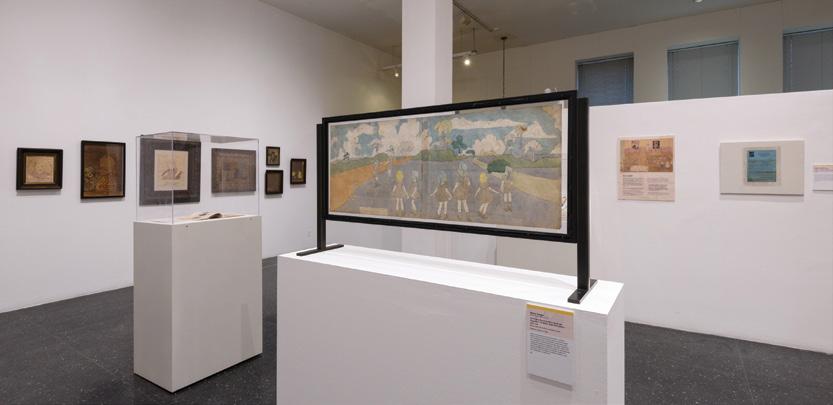
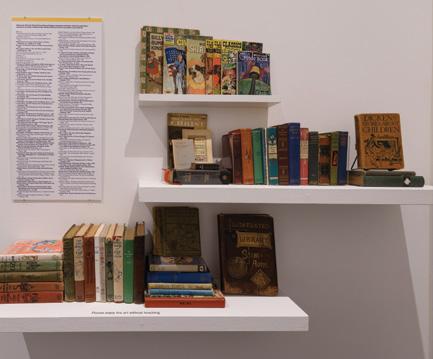
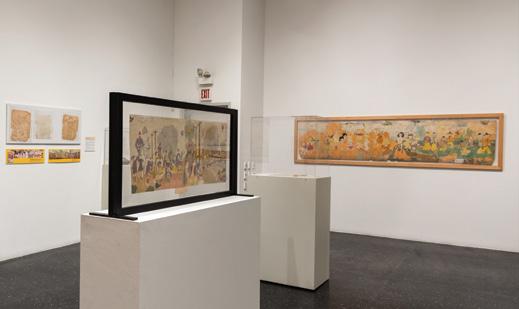
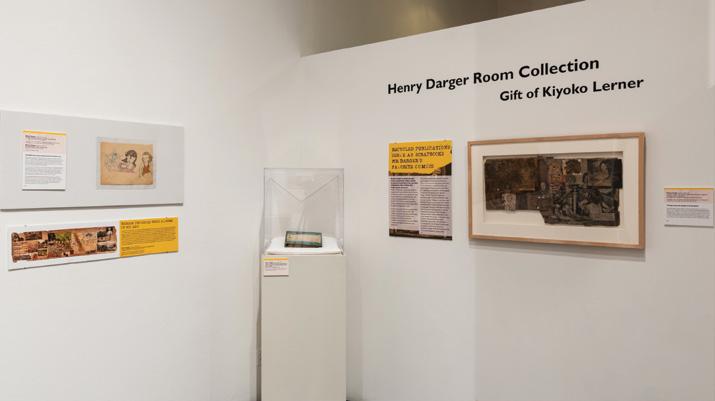 Installation views of Henry Darger: The Room Revealed exhibition series (June 11 –November 28, 2021), Intuit: The Center for Intuitive and Outsider Art
Photographs by Cheri Eisenberg
Installation view of the Henry Darger Room Collection at Intuit: The Center for Intuitive and Outsider Art.
Photo © John Faier
Installation views of Henry Darger: The Room Revealed exhibition series (June 11 –November 28, 2021), Intuit: The Center for Intuitive and Outsider Art
Photographs by Cheri Eisenberg
Installation view of the Henry Darger Room Collection at Intuit: The Center for Intuitive and Outsider Art.
Photo © John Faier
Dear friends of Intuit,
In this summer’s exhibition, Darger as Reader, Writer and Bookmaker, guests were invited to read excerpts from the artist Henry Darger’s novel, In the Realms of the Unreal, alongside almost identical excerpts from Uncle Tom’s Cabin, Alice’s Adventures in Wonderland and The Road to Oz. How did these excerpts find their way into the artist’s 15,000-page goodversus-evil novel? Darger had lifted entire sections of others’ novels to fill his own.
Thanks to Michael Bonesteel, who made these writing discoveries, along with fellow Darger scholars Leisa Rundquist and Mary Trent—and with funding support from the Terra Foundation of American Art—Intuit highlighted many fascinating new insights into this most mysterious artist in a series of three evolving exhibits that served as a living laboratory to explore what themes were most interesting to Intuit audiences. Feedback gathered from guests will inform a future re-imagined Darger Room and historical exhibition.
The three exhibits in the series Henry Darger: The Room Revealed prepared Intuit and guests for the dismantling of the museum’s crown jewel, the Henry Darger Room. Our precious Darger collection faces an urgent challenge. Many of the objects in the Room, especially those made of paper, are fragile and deteriorating with time.
With a grant from the National Endowment for the Arts, Intuit is working with a conservation specialist to stabilize these objects and review them to set conservation priorities. This means the objects have been removed, and the Room is in a transition period.
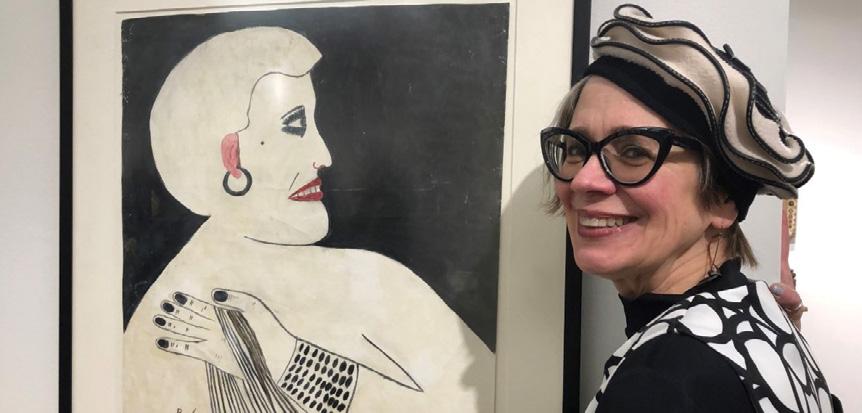
Guest feedback on the exhibitions in the series indicates a desire to see more art, an interest in an opportunity to try out for themselves Darger’s method of tracing pages from coloring books (which resulted in some of his most iconic images), a fascination with the biographies of the characters from the novel, and an appreciation for delving into Darger’s interests ranging from Catholic saints to Shirley Temple to contemporary current events. Over the next months, Chief Curator Alison Amick and her team will continue to explore new discoveries about Darger’s life and work and share those with our audiences through in-person and virtual exhibitions. You can check out the series Henry Darger: The Room Revealed on our website under Past Exhibitions.
Thank you for supporting Intuit and our work to advance the scholarship on outsider art and artists.
Warm regards, Debra Kerr, President and CEO
THE PRESIDENT
LETTER FROM
5
LETTER FROM THE PRESIDENT
Comics of the Day Influenced Darger,s Artworks
By Michael Bonesteel

Henry Darger’s abiding interest in comics—as mirrored in the comic books in his library, the newspaper strips he cut out and pasted into numerous scrapbooks, and folders of collected comics and cartoon images to be traced into his own work—had a significant impact upon narrative continuity and the sequential arrangement
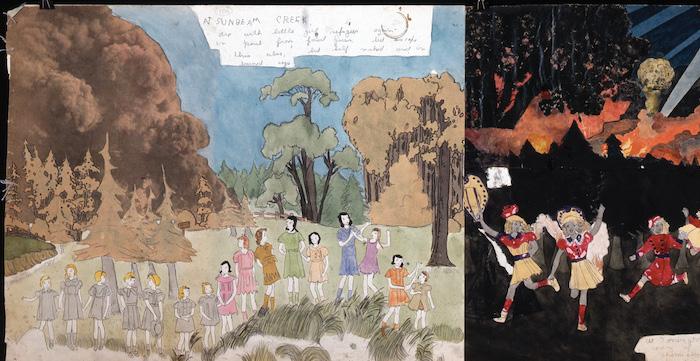
Henry Darger (American, 1892-1973). At Sunbeam Creek, are with little girl refugees again in peril from forest fires. but escape this also, but half naked and in burned rags. / At Torrington. Are persued by a storm of fire but have them lives by jumping into a stream and running across as seen in next picture / At Torrington. They reach the river just in the nick of time. Their red color is caused by glare of flames... (double-sided), mid-20th c. Watercolor, pencil, carbon tracing and collage on pieced paper. 19 x 70 1/2 in. Collection of American Folk Art Museum, New York. Anonymous gift in recognition of Sam Farber © Kiyoko Lerner. 2004.1.2A.
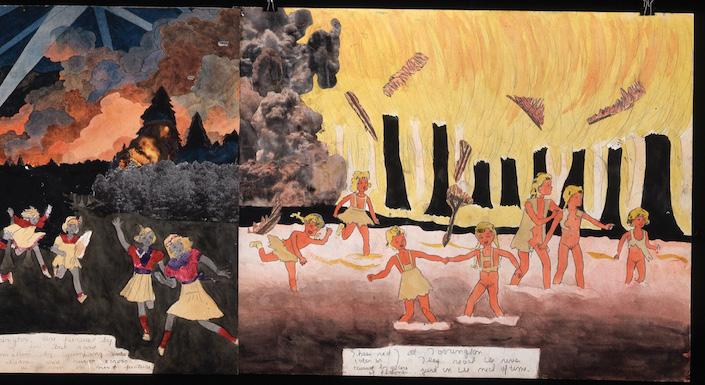
Photograph by James Prinz © 2022 Kiyoko Lerner / Artists Rights Society (ARS), New York
In the 1930s, Darger began combining some of his older, single-paneled watercolor, collage and carbon-traced artworks, inspired by written episodes from his epic novel, In the Realms of the Unreal, to create twopaneled diptychs, three-paneled triptychs, and, sometimes, even four- and five-paneled works. Despite a superficial resemblance to comic strip panels, these multiple-paneled works assembled from earlier scenes bear little or no sequential relationship to one another. It often appears as if these multiple panels, randomly joined together on one side, were combined mainly to provide a surface for the longer panoramas he executed on the other side. Occasionally, however, his multiple-paneled scenes reflect deliberate thematic similarities.
In a triptych titled AT SUNBEAM CREEK. Are with little girl refugees again..., the left-hand panel takes place at the named creek, while both the center and right panels are located at a place and or river called Torrington. Nevertheless, in all three scenes, the Vivian Girls are trying to escape a deadly and aggressive forest fire. There is even a progression, of sorts, from panel to panel. The first scene depicts the sisters with child-slave refugees at a safe distance away from the collaged smoke billowing from the pine trees behind them. The caption informs us that very soon these fully dressed girls will barely escape “half naked and in burned rags.” The center panel finds the seven Vivian princesses by themselves, running through deep gray shadows that contrast with the blazing red fires in the background. The caption states they will “save themselves by jumping into a stream and swim across as seen in the next picture.” That “next picture” is, indeed, the third panel here, and, as predicted in the first panel, the girls are now “half naked and in burned rags.”
COMICS OF THE DAY INFLUENCED DARGER'S ARTWORKS
They have reached the Torrington River “in the nick of time,”and “Their red color is caused by the glare of flames.”
red color
A rather rare and conspicuous example of Darger’s clear use of sequential art is a diptych executed in the 1930s titled At Jennie Turmer. Her experience and the result of her—desperate struggles for air when he strangled her. She fell with him hundreds of feet, but landed on top of him, and only he was killed [...] 2000 feet below where they were first. It may be one of his earliest diptychs and displays several rather awkward elements. For one thing, the two panels are of varying sizes, the top edge of the right panel extending slightly above the top edge of the left one. More problematic is the fact
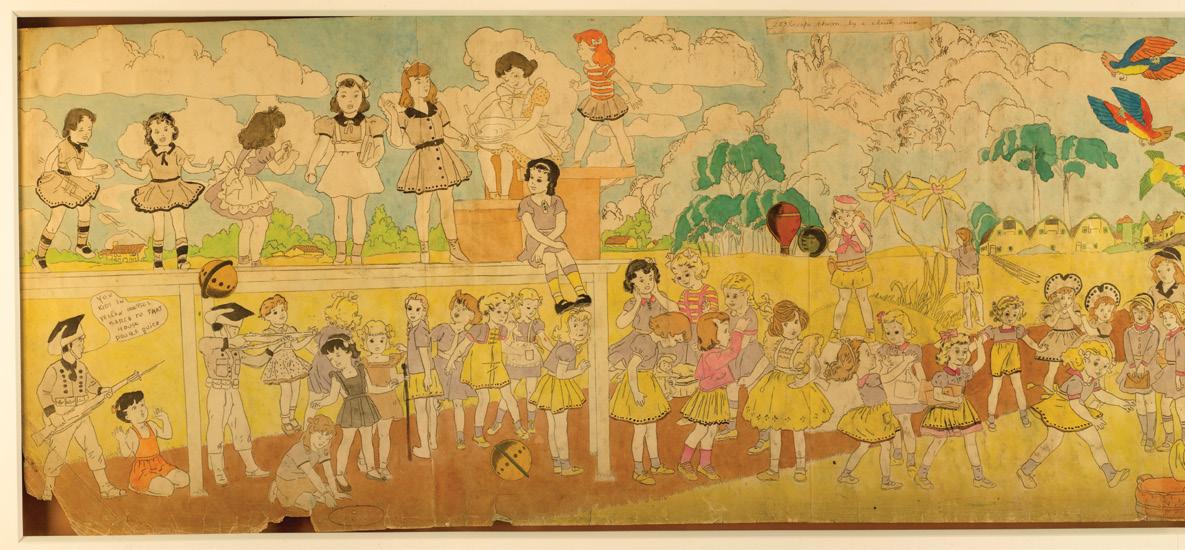
that the obviously succeeding actions read from right to left instead of the usual (at least in Western comics) left to right. Darger makes the progression perfectly apparent by labeling the caption in the left-hand panel 2 and the caption in the right panel 1. We can also see that the first scene, chronologically, on the right, pictures an evil Glandelinian character choking a girl with one hand as he tries to climb up a very steep wall of red rock using his other hand; the scene on the left shows them both at the foot of the steep wall, the girl standing over the man’s dead body. It is perhaps the only work of its kind in Darger’s oeuvre, and it is telling that he did not execute more like it but, instead, chose other methods of conveying sequential movement.
Darger’s more frequent method of presenting successive activity is found in his mature work of the 1940s and ’50s. As his scenes grew more sweepingly panoramic, he attempted to depict an increasing number of situations taking place simultaneously within one extensively wideangle landscape. Space and time expand within these increasingly elaborate and complex scenes. A good example of this is a middle-to-late period (ca. 19501960), double-sided piece titled 204 They Are Cleverly Outwitted... / 205 While Inside They Await Developments One side of this work is an outdoor scene that features two Glandelinian boy scouts in gray uniforms aiming their

8 THE OUTSIDER
“Their
is caused by the glare of flames.”
Henry Darger (American, 1892–1973).
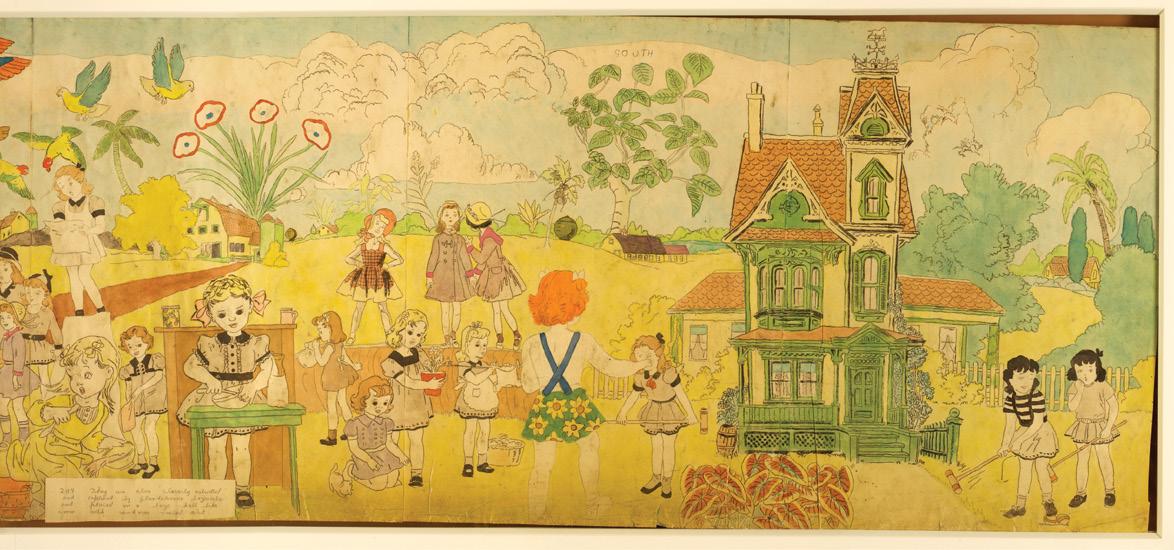
204 They are cleverly outwitted and captured by glandelinian boyscouts and placed in a large hall like room with windows nailed shut, c. 1950-60. Mixed media, dimensions unknown. Collection of Audrey B. Heckler. Photograph © 2021 Visko Hatfield. © 2022 Kiyoko Lerner / Artists Rights Society (ARS), New York


rifles at a group of young girls milling among a larger number of Glandelinian girl scouts. One of the young soldiers addresses the crowd in a word balloon: “You kids in yellow dresses march to that house double quick.” Darger began incorporating a standard comic device of putting dialogue in balloons more and more in his later work. The house referred to is a detailed tracing of a Second Empire-style mansion standing at the far-right side of the composition.
Although there are at least 11 girls in yellow dresses that might qualify as the seven Vivian sisters and their honorary sister, Gertrude Angeline, those girls can be positively identified as the ones with a row of tiny purple dots circling above the purple band running around the hem of their yellow skirts. They are also wearing gray blouses (just as they do in the first panel of the AT SUNBEAM CREEK triptych previously discussed), indicating that they are disguised as Glandelinian girl scouts—a role they frequently assumed when going undercover as spies behind enemy lines. But the jig is up, as they say, for the caption located at the bottom center reads: “They are also cleverly outwitted and captured by Glandelinian boy scouts and placed in a large hall like room with windows nailed shut.” A figure just above the caption is a character that regularly appears in Darger’s late works: “Little Miss Muffet” traced from a coloring book page.
COMICS OF THE DAY INFLUENCED DARGER'S ARTWORKS
Henry Darger (American, 1892–1973).
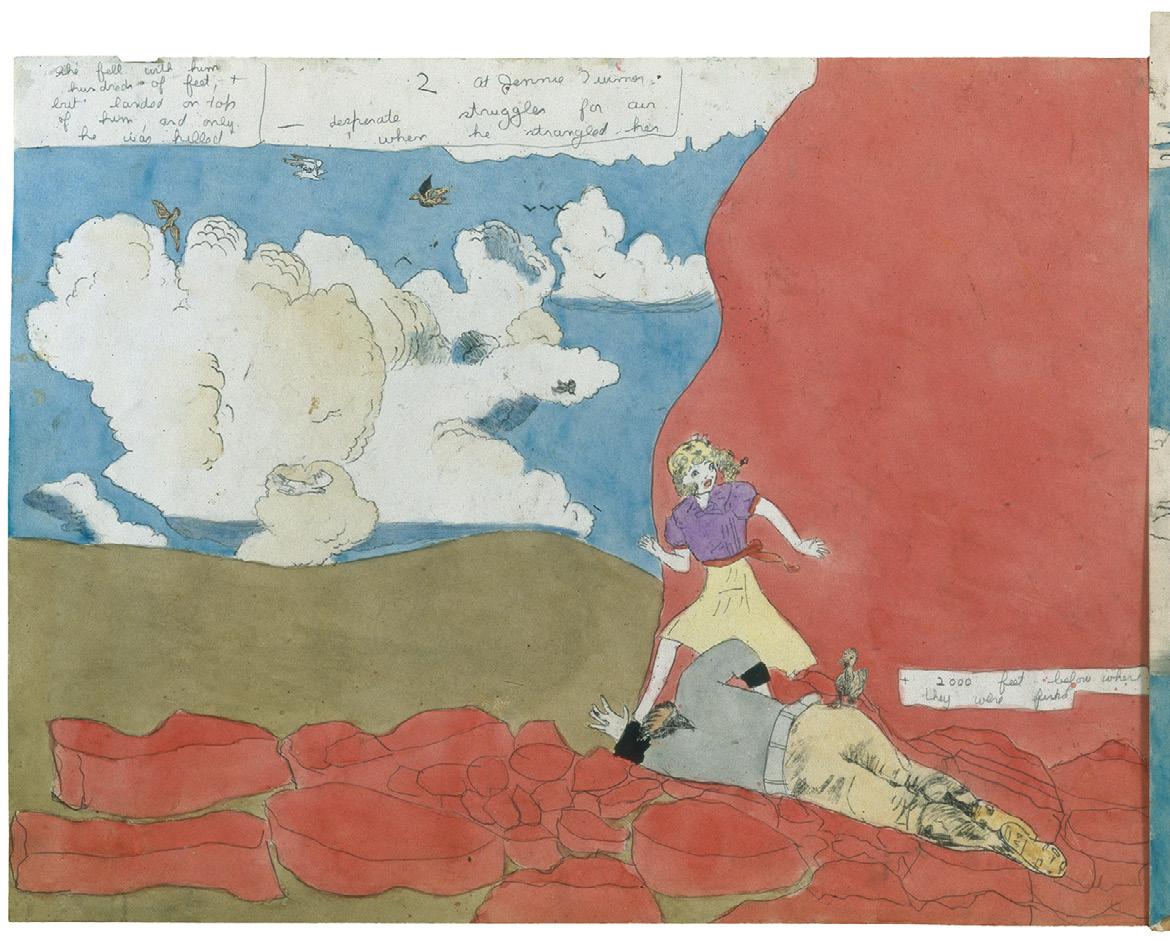
2 At Jennie Turmer - desperate struggles for air when he strangled / 1 At Jennie Turmer. Her experience and the result of her., n.d. Watercolor, pencil and carbon tracing on pieced paper, 19 x 49 in. Collection of Robert M. Greenberg.
Photograph © 2021 Visko Hatfield.
© 2022 Kiyoko Lerner / Artists Rights Society (ARS), New York
10 THE OUTSIDER
COMICS OF THE DAY INFLUENCED DARGER'S ARTWORKS
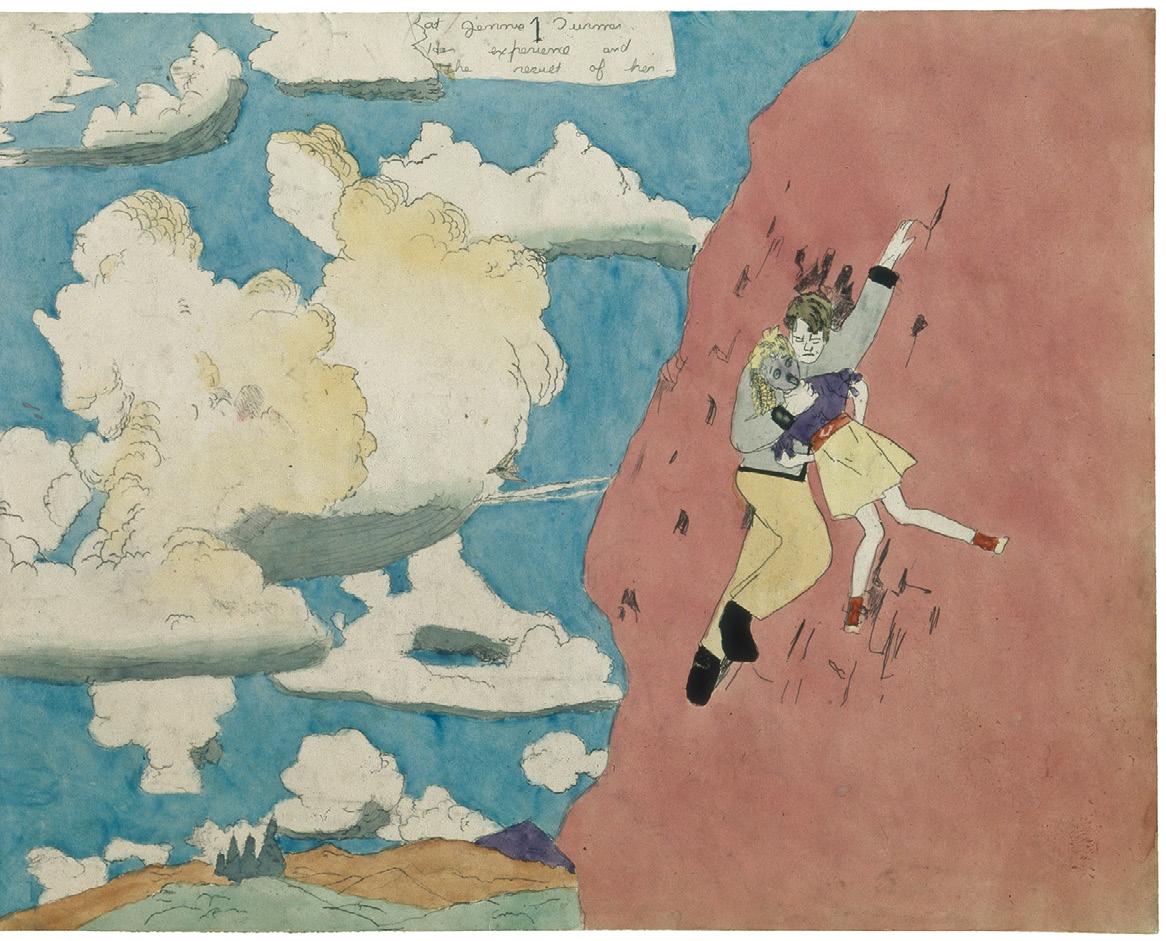
11
Henry Darger (American, 1892–1973). 205 While inside they await developments, c. 1950-60. Mixed media, dimensions unknown. Collection of Audrey B. Heckler. Photograph © 2021 Visko Hatfield. © 2022 Kiyoko Lerner / Artists Rights Society (ARS), New York

The action is seemingly continued inside the house on the other side, where the caption states: “While inside they await developments.” Above the caption stands a conspicuous central character in a pink dress with yellow buttons that was not in the outdoor scene on the opposite side, whereas Miss Muffet reappears here at the very far right. Inexplicably, only five recognizable Vivian Girls are pictured (as opposed to the typical seven). As in other Darger compositions, there are strange, incongruous constructions, like the group of girls framed behind a sort of double-paned window. One of the girls within is occupied with hanging a curtain rod on another window that is rather oddly placed. It is almost as if there are two different realities with independent perspectives coexisting in the same space. This is probably the result of Darger’s whimsical placement of a scene appropriated from a separate source whose perspectives clash with the dominant one here. Group portraits of children hang between three very unusually designed configurations on the back wall that look like combinations of bed headboards and window frames.
It is worth noting there is a very similar piece to the verso side of the above work, Untitled (Part 2 of 205), that appears to be a further continuation of activities elaborating on what has gone before. Although this interior scene contains different portraits of children in ornate frames hanging

12 THE OUTSIDER
Space
on the walls, both the girl in the pink dress and Miss Muffet are back again. As Darger moved from one composition to another, he was apparently fascinated with creating variations on a theme, keeping similar elements,discarding others, while adding new ones.
For many years, Darger scholars have wondered if there was any continuity between the larger, double-sided works (nearly all his visual art, in fact, except the early one-sided, single-panel pieces) that the artist handbound together in three large “albums” that were subsequently disassembled and dispersed as several hundred separate works of art. In 2018, American Folk Art Museum Curator Valérie Rousseau gave a presentation in which she revealed her attempt to rebuild one of those albums from the only remaining “spine,” which contained just enough recognizable material to match it up with corresponding Darger works in the museum’s collection. For the first time since the work was discovered, one could view the sequence of 42 double-sided works (a total of 84 panoramas) dating from 1930 to 1940 as Darger originally intended them to be grouped. The conclusion Rousseau reached, however, was that there did not seem to be any apparent chronology or continuity in sequencing from one work to the next within that album.
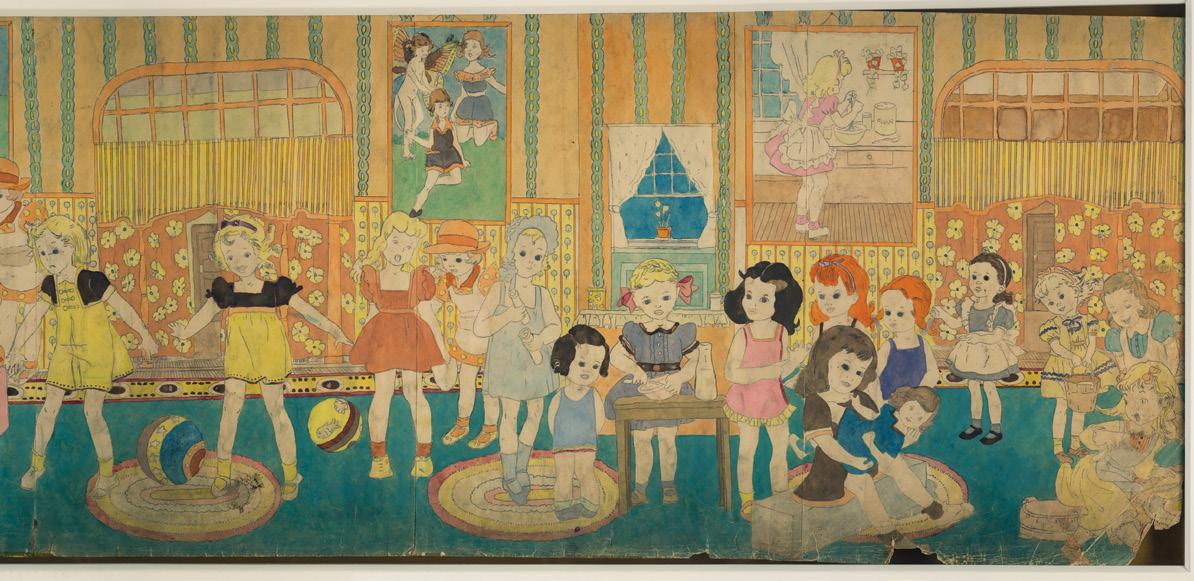


and time expand within these increasingly elaborate and complex scenes.
COMICS OF THE DAY INFLUENCED DARGER'S ARTWORKS
SOME THOUGHTS ON THE RECENT PAST AND FUTURE OF OUTSIDER AND SELF TAUGHT ART
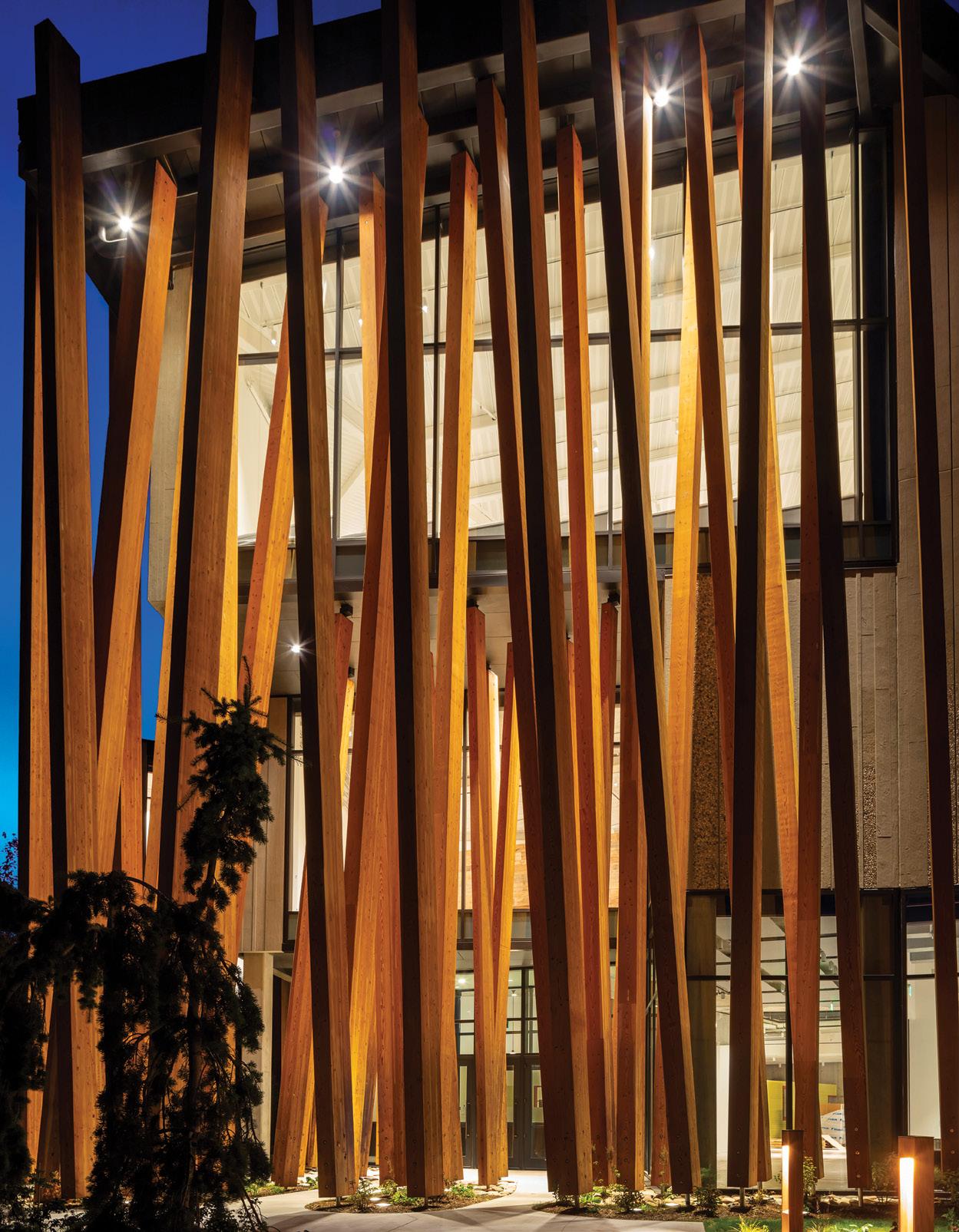 BY LEISA RUNDQUIST
BY LEISA RUNDQUIST
I’m an academic and occasional curator. I like to say that I am “Intuit adjacent” as I have been closely affiliated with Intuit as a scholar and colleague since 2015. However, my Intuit roots run deeper. I’ve been a member since the 1990s and studied objects and ephemera from the Henry Darger Room Collection for nearly two decades.
I keep my eye on new research—new perspectives that expand the depth and breadth of ideas in the field of outsider and self-taught art. In the past 20 years, scholars have gained significant inroads into the background of artists as well as the cultural contexts of their artwork. More attention has been given to the circumstances surrounding the artwork, resulting in fresh interpretations and provocative questions that pique more curiosity. I return time and time again to the work of several scholars whom I feel have a profound influence on the field and continue to challenge conventional thinking: Joanne Cubbs, Bernie Herman, Charles Russell and Leslie Umberger. Cubb’s 2012 exhibition, Hard Truths: The Art of Thornton Dial, was truly a tour-de-force show and catalog revealing Dial’s mastery and experiences. I still vividly remember this exhibition, which I saw twice in two different locations.
The Art Preserve of the John Michael Kohler Art Center, Sheboygan, Wisc. Photographs by Durston Saylor, courtesy of John Michael Kohler Art Center
SOME THOUGHTS ON THE RECENT PAST AND FUTURE OF OUTSIDER AND SELF-TAUGHT ART
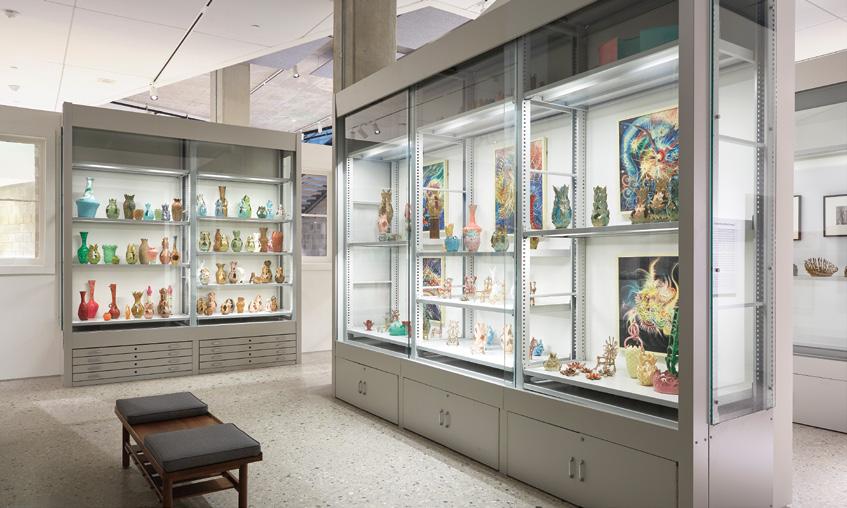
15
Installation views of Between Worlds: The Art of Bill Traylor exhibition (September 28, 2018–April 7, 2019), Smithsonian American Art Museum
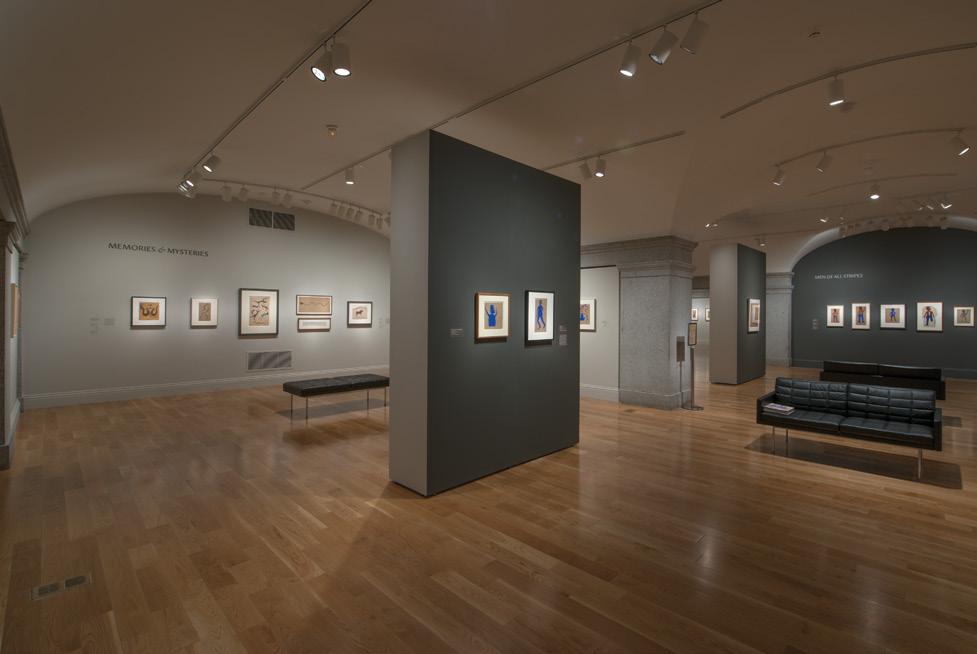
Photographs courtesy Smithsonian American Art Museum

16 THE OUTSIDER
Herman’s work on what he calls the “Birmingham-Bessemer school,” specifically his contributions on the art of Ronald Lockett, Lonnie Holley, Thornton Dial, Joe Minter and the Gee’s Bend quiltmakers, has not only engendered multiple exhibitions and essays but a whole generation of graduate students making significant contributions to the field. Russell’s 2011 Groundwaters is still my “go-to” text for teaching my own students. This book was one of the first to provide concise histories on the use of terms such as “folk,” “art brut,” “outsider” and “self-taught” while also featuring several essays on individual artists categorized within those genres.
The 2018 exhibition, Between Worlds: The Art of Bill Traylor, curated by Umberger, is one of the finest exhibitions to date. Comprehensive and insightful, the exhibition and catalog set a high bar for future scholarship and monographs on artists. Several other scholars and institutions—too many to name here in this short essay—have also made significant contributions to the field. Two that come immediately to mind are Valérie Rousseau and the American Folk Art Museum in New York and the late Ruth DeYoung Kohler and the John Michael Kohler Arts Center in Sheboygan, Wis. Kohler’s legacy is solidified by the newly opened Art Preserve that is unquestionably one of the most unique and exciting multipurpose facilities showcasing both preservation and curatorial practices. Alongside tremendous growth in exceptional scholarship, the field has witnessed the continuance of the widely popular and critically acclaimed Outsider Art Fairs of New York and Paris owned by Andrew Edlin. Established in 1993, the quality of these fairs has garnered the admiration of noteworthy art critics, including Roberta Smith of The New York Times. Likewise, new artists have been introduced to the art world via pioneering foundations such as Souls Grown Deep and the late Bill Arnett. Founded in 2010, Souls Grown Deep established a notable model for stewarding the work of marginalized Black American artists. To date, the foundation has facilitated the acquisition of more than 350 works by 100 artists into major museums across the United States. As important, the dissemination of information, exhibition and book reviews, and news within the field continues via mainstay publications like the international Raw Vision Magazine and Intuit’s The Outsider as well as a wealth of more recent contributions in Hyperallergic and other digital media by passionate writer and curator Edward M. Gómez.
17
SELF-TAUGHT ART
SOME THOUGHTS ON THE RECENT PAST AND FUTURE OF OUTSIDER AND
Installation views of Chicago Calling: Art Against the Flow exhibition (June 29, 2018–January 6, 2019), Intuit: The Center for Intuitive and Outsider Art Photographs by Cheri Eisenberg

My recent experience working with two knowledgeable and dedicated Darger scholars—Michael Bonesteel and Mary Trent— along with Alison Amick, chief curator at Intuit, prompts me to advocate for a future of more collaboration and shared resources between scholars and institutions, both in the United States and Europe. Recent collaborations between the American Folk Art Museum and Museum Dr. Guislain (Ghent, Belgium) for the exhibition Willem van Genk: Mind Traffic (2014) and Intuit with Halle Saint Pierre (Paris), Kunsthaus Kaufbeuren (Kaufbeuren, Germany), Collection de l’Art Brut (Lausanne, Switzerland), and the Outsider Art Museum (Amsterdam) for Chicago Calling: Art Against the Flow (2018–2021) are prime examples of successful collaborations and leadership from these institutions. As the field of outsider and selftaught art matures, it’s my hope that we embrace shared projects and exhibitions, continue nurturing future scholars and specialists, and reach out to individuals working within and beyond the art world to garner diverse perspectives and more inclusive viewpoints.
Leisa Rundquist is a professor of art history at University of North Carolina Asheville. She is the author of The Power and Fluidity of Girlhood in Henry Darger’s Art (2021), reviewed on page 33, and guest curator of Betwixt and Between: Henry Darger’s Vivial Girls (Intuit, 2017). She made contributions to the exhibition series Henry Darger: The Room Revealed (Intuit, 2021). Rundquist is currently working on an article for the International Panorama Council Journal regarding panoramic landscapes in Darger’s art
18 THE OUTSIDER
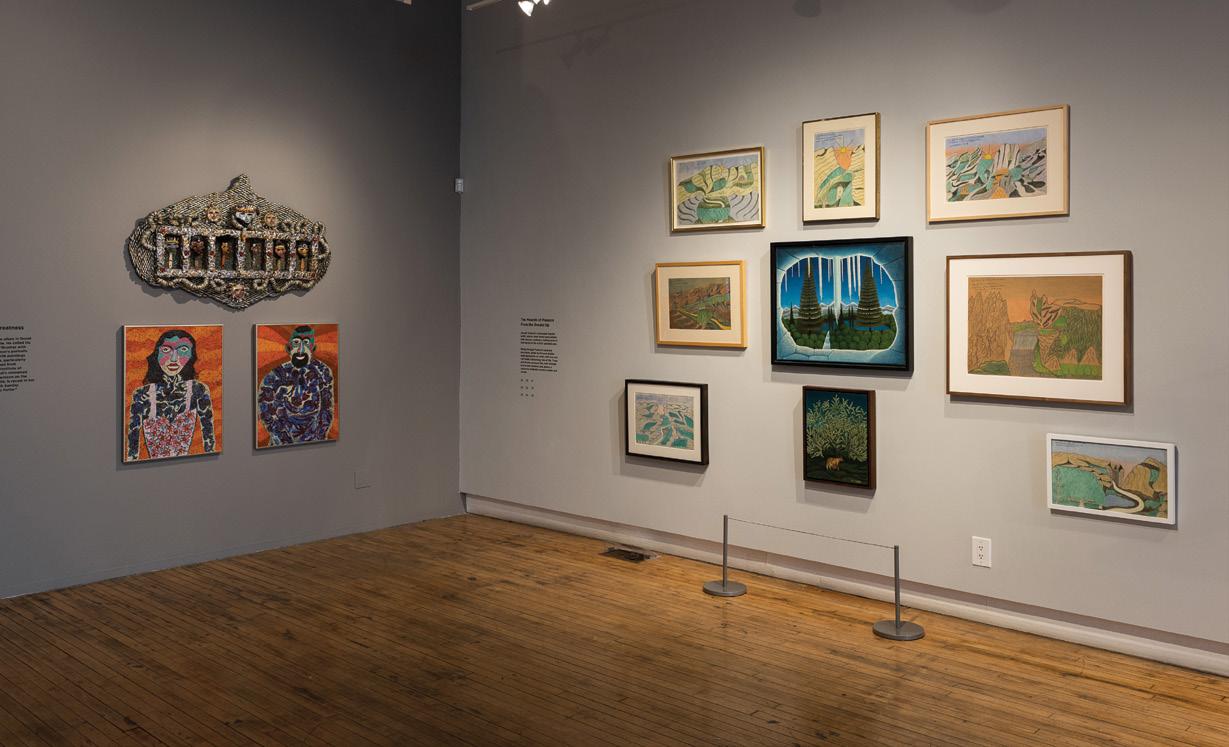

Walking in Beauty
 By William Swislow
By William Swislow
Roman Villarreal is self-taught in the strictest—and arguably richest—sense of the term.
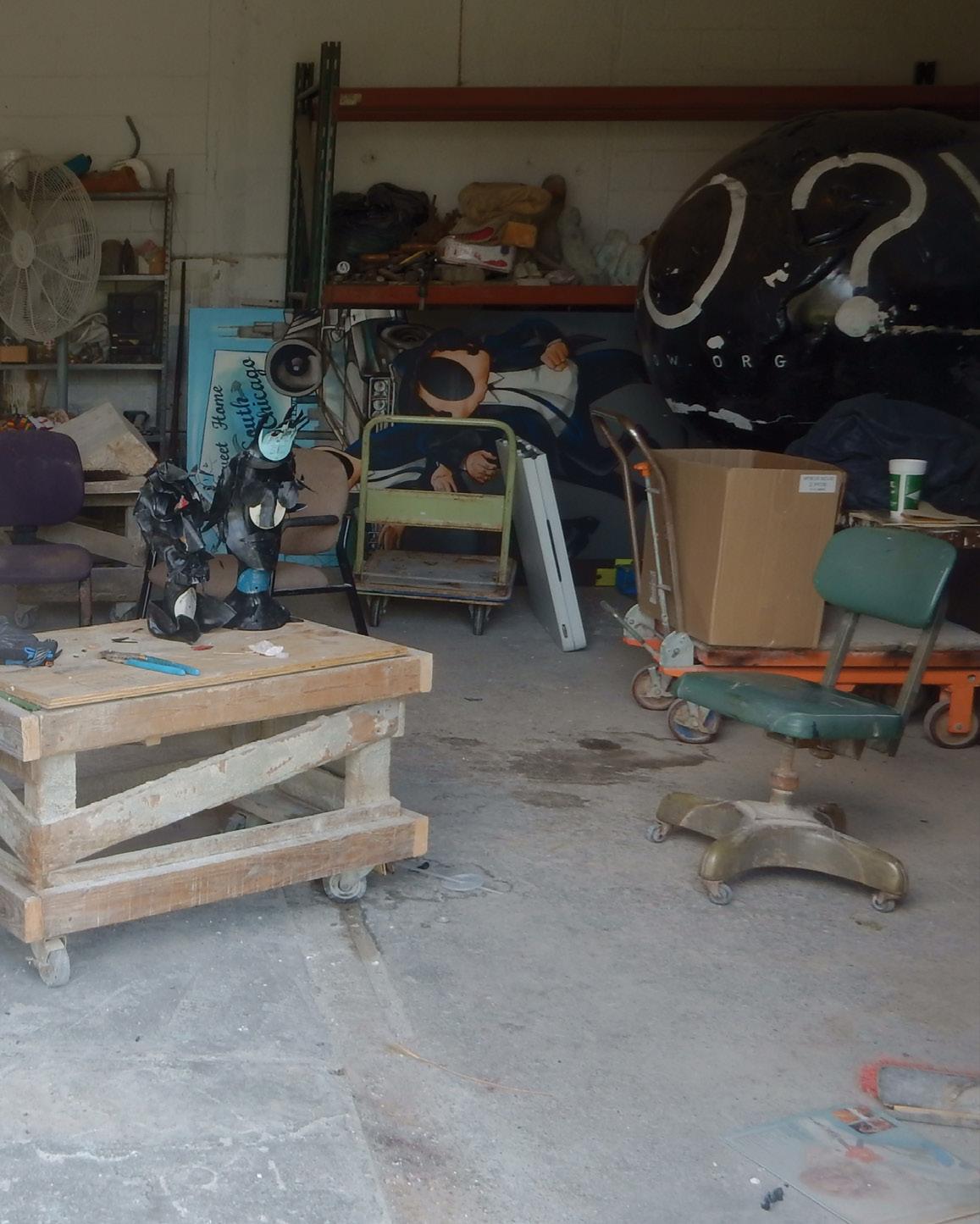
He started modeling with clay as a young boy, he says, then moved on to wood and eventually to his premier medium, stone. And as he figured out for himself how to turn his materials into objects of meaning and beauty, he also chose to teach himself all he could about art—and from the masters. When asked if anyone mentored him, his first answer is “Miró.”
This, of course, puts him outside the guideposts of art brut, along with other artists who ultimately engaged with the art world, like Mr. Imagination, Michel Nedjar and Lonnie Holley, among others. But for self-taught artists determined to connect with art beyond their own creations, descriptors needn’t be cages. In Villarreal’s case, as in others, it’s still an artist mostly figuring out for himself what those “mentors” and their styles mean and what he can learn from them.
“I would always look at books. Since I'm a selftaught artist, a lot of my education came through research on my own part,” he says. “I was always, always fascinated with the masters. You know, what they did, how they dealt with color, how
they approached it, the different periods in art history… As an outside artist, you absorb this all by yourself… You never stop studying. You see something and you want to try it.”
And he tried many things. “I experimented a lot in the early years, because I was trying to find myself and what direction I was going in…experimenting with all the media [and] the Cubist, the realist movement and the different styles. One year I would do a series of Cubist. The following year I would start doing this or that, but I was slowly, slowly, developing…all these things I would do on my own until I felt I got it.”
As with many self-taught artists in Chicago, the Art Institute of Chicago, both the museum and school, played a role in this process of figuring art out.
“The Art Institute was the world that I thought I belonged in. I could envision myself in the early years when I would go there, that one day I was going to be one of these artists."
WALKING IN BEAUTY 21 Beauty
Roman Villarreal in his studio. All photography by William Swislow
Villarreal also spent time hanging around the School of the Art Institute. Some friends from the neighborhood, a working-class community on the city’s far South Side, were attending, he says, and he took advantage of that entree to learn technique and hear about what other artists were doing. He never enrolled and never got a degree, however.
“I wanted to be an artist, but I didn’t need the degree. I felt, if I’m an artist, what do I need this piece of paper to say I’m an artist. There's a difference, the degree and learning, and mine was not the degree, mine was learning. Little did I realize the importance of the degree, but at that time it wasn't important.”
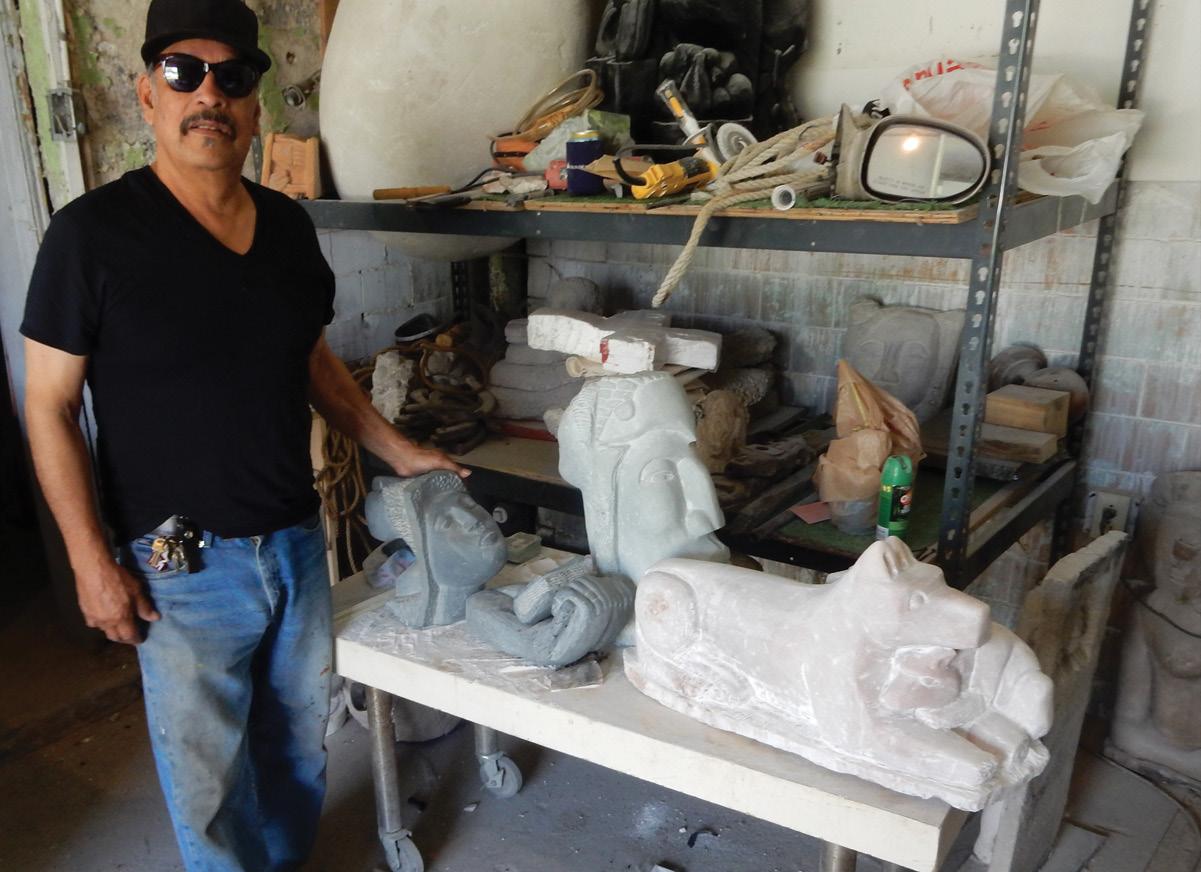
22 THE OUTSIDER
And he tried many things.
The artists who inspired Villarreal weren’t only the kinds you find in museums like the Art Institute, however. “There was a book that was called Fantasy something, and that was a perfect example of artists like myself… This is the one that I look at and I think to myself, ‘Wow, I would love to do large-scale this and that.’”
When he pulled the book out, it was Fantasy Worlds by John Maizels and Deidi Von Schaewen, an exploration of art environments around the world. “The funny thing to me is that a lot of them are strange old guys. So, I must be one of these strange old guys. Because I love it.
“It's like the guys that worked in this Fantasy Worlds. I could imagine these men getting up at six o'clock in the morning, working, working, working, go drink a bottle of wine, go to sleep, get up the next day, ‘cause they love what they're doing. And the passion is there in this book.”
Villarreal considered following their example literally but hasn’t got there, yet. “One day, I got together with some friends, and we were going to board up the house with panels, and we were going to do a series of three-dimensional sculptures on the wall. But it kind of takes you away from insurance. They look at your house
like, ‘what the hell did you do?’ So, I had to stay kind of traditional, and I went for siding. But I'm still considering doing my doors, and I'm going to decorate my backyard really elaborate.”
At 69 (when interviewed for this piece), Villarreal is acutely aware of both the pluses and minuses associated with being a self-taught artist.
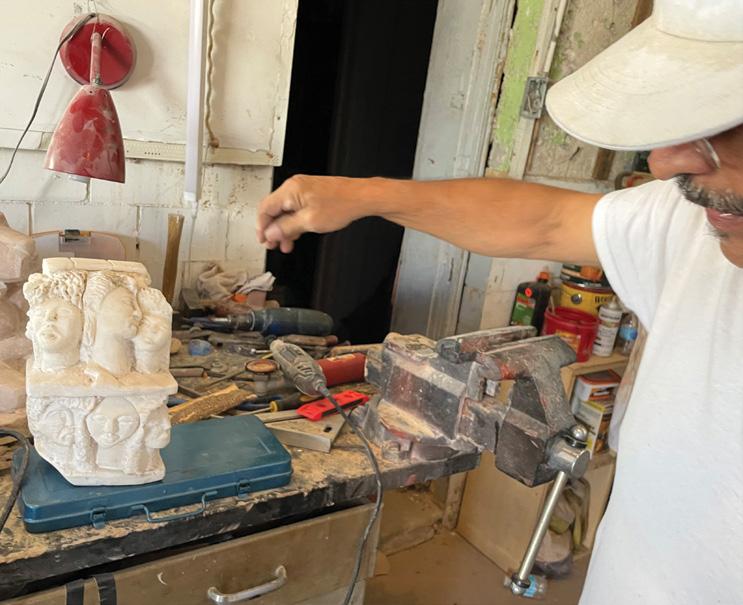
“For art history, they're going to remember us, but it's not gonna be the same thing as academia… I had to accept the fact that no matter what happens in life, everybody who stepped into academia is going to be considered before I'm going to be considered. So my role as an outside artist is: don't worry about it. Just keep working, keep working your own.
“I learned to be proud of the fact that I'm an outside artist. At first a lot of us that were outsider artists, we were kind of bitter. But then we have to realize, that's not the way it works. We have to understand, hey, man, we're in this, we did this.”
Villarreal’s particular path of work was not conventional where he grew up, making him an outlier in his own community as well as the art world.
“I mean, this is an industrial working-class community. Could you imagine going to a bar and talk to somebody about Dada… They look like, ‘what are you, a nut?’ Nobody knew what the hell you were talking about. But this was what fascinated me.”
Although an artist from a young age, in 1967 he nonetheless followed his father, a Mexican immigrant, into work at the U.S. Steel plant on Chicago’s far South Side. He went into the army after that but then returned to a job at the mill.
“My plan was, I was going to retire from the mills and then still be an artist. That was the plan. But they closed them. One day we go to work, and it’s gone. The whole era of the mills was gone. That's when I made the decision that I was to be the master of my fate. I was no longer going to be dependent on paychecks and this and that. This was a gamble. It was during the ’80s when I quit working completely for the world, and I started just doing for myself.”
Villarreal did not stray far from mill town, however. He lives less than a mile from the site of the old South Works, now a park whose entrance, not coincidentally, features a Villarreal statue in bronze commemorating the steelworkers and their families. Although Villarreal does not view himself as a political artist, there is something inherently political in his work and, in a sense, who he is.
“I am an urban artist. There's no two ways about it. I remember years ago I had a discussion with some Indiana artists, and they were landscape artists. What they were painting was barns and beautiful scenes... I was seeing gangbangers, prostitutes, urban this and this, so that's what I was portraying, because this is what I would see outside of my window.
“If I lived on a farm, of course, I’d be painting chickens and sunsets and stuff like that. But that's not what I see. I used to tell people that I was an urban anthropologist, because when they’re going to study what happens in life, they come to the artist to see what we were doing during that time. We weren't hiding nothing. I was showing the rawness. When the gang killings started in the ’90s, there were big shootings constantly and people were dying. I portrayed that in my paintings. You can't sell them, but that's what was happening.”
For Villarreal, art not only portrays the realities of his community it also represents the possibility of renewal. “Art is the new steel,” he likes to say. It can provide the fiber to pull the neighborhood together.
“[As] an urban artist, there's 20 issues that you get bombarded with… I'd rather just concentrate on one thing and one thing only: The development of arts and our communities. Then we'll worry about the other issues.
“When the mills closed, the problem with this community was everything went up—alcoholism, divorces, more criminal activity. And then the children of the men who came from the steel mills got involved in gangs. And then in the ’90s, we call it the bloody ’90s, because this neighborhood went nuts, nuts. They were killing each other left and right.
24 THE OUTSIDER
“I am an urban artist. There's no two ways about it.”
“But see, this was energy. If you could…channel that energy to something else… That's why places like SkyART [a local arts program] and the things that we have in our community here are so important. What they're doing is adding this extra element for that energy.”
Villarreal himself has taught and mentored many artists over the years and worked with a variety of art programs for young people. He continues to make art as well, of course, often with whatever materials are at hand. That includes bars of soap, which he has carved into lovely little portraits; hunks of foam, which he carves like wood; and old vinyl LPs, which he has melted and shaped into portraits and animal figures. He’s also tried his hand at spray paint.
“The young guys right now that are working with the spray can, they're amazing,” he says. “The spray can has developed to a whole new level—the can, the caps, the distance of the spray and all that. I've been messing with it a little bit, still not me yet. I am spraying a little bit, [but] it's expensive. Every time
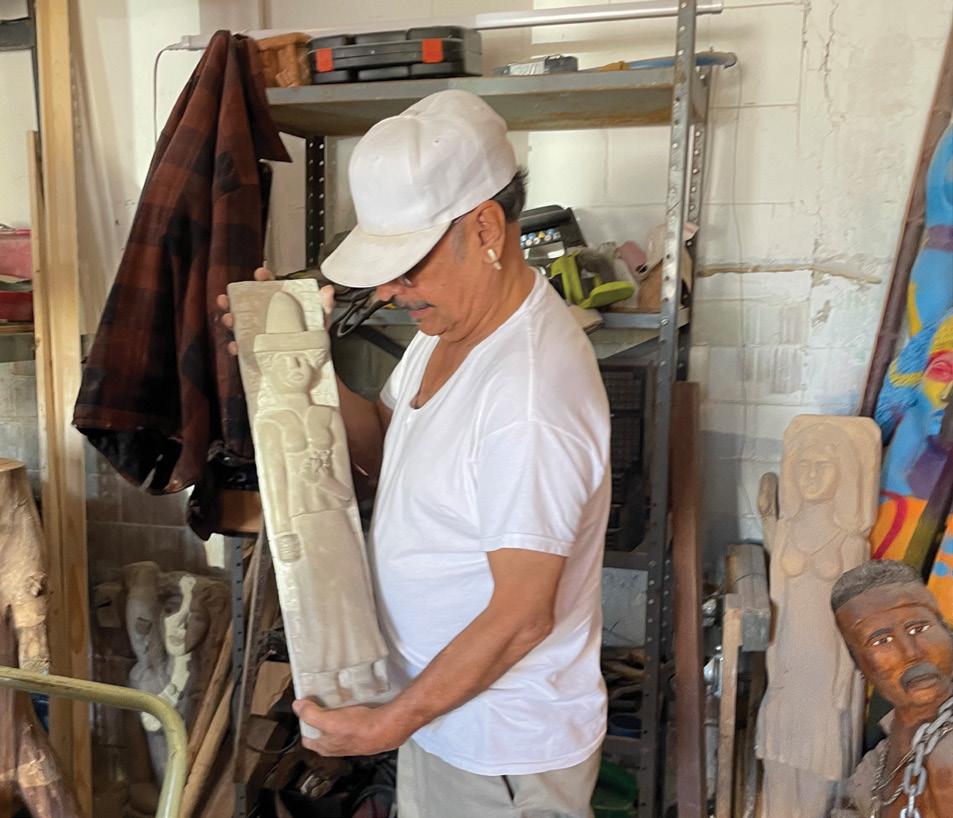
25
WALKING IN BEAUTY
these kids go out and spray, they're investing a couple of hundred dollars’ worth of paint. And it's only going to be there for a day, two days. The city’s going to wash it off, or another crew’s gonna come and wipe it out. But they want the photographs, that's all they care about.”
Some of those young artists with their spray cans work side by side with Villarreal in Nine 3 Studio, an old service station in the shadow of the Chicago Skyway toll road that he has adapted for artist studios. Villarreal’s stone sculptures line one large room, along with some maquettes and his work in other media.
Villarreal also remains a prolific painter, lately using his fingers in place of a brush. “Being a sculptor,
something clicked inside me that came like second nature, because you're manipulating things with your fingers. So, I was able to control the paint in a certain way.”
Reflecting his core identity as a stone carver, Villarreal has executed commissions around the city. He has limestone figures—all highly accomplished—in a number of city parks, as well as the steelworker statue.
Perhaps his best-known contribution to Chicago’s parks, a life-size mermaid, was a surreptitious creation by Villarreal and three friends over a couple of weeks in the summer of 1986. They carved the mermaid into one of the limestone blocks that once lined half of the city’s lakefront.
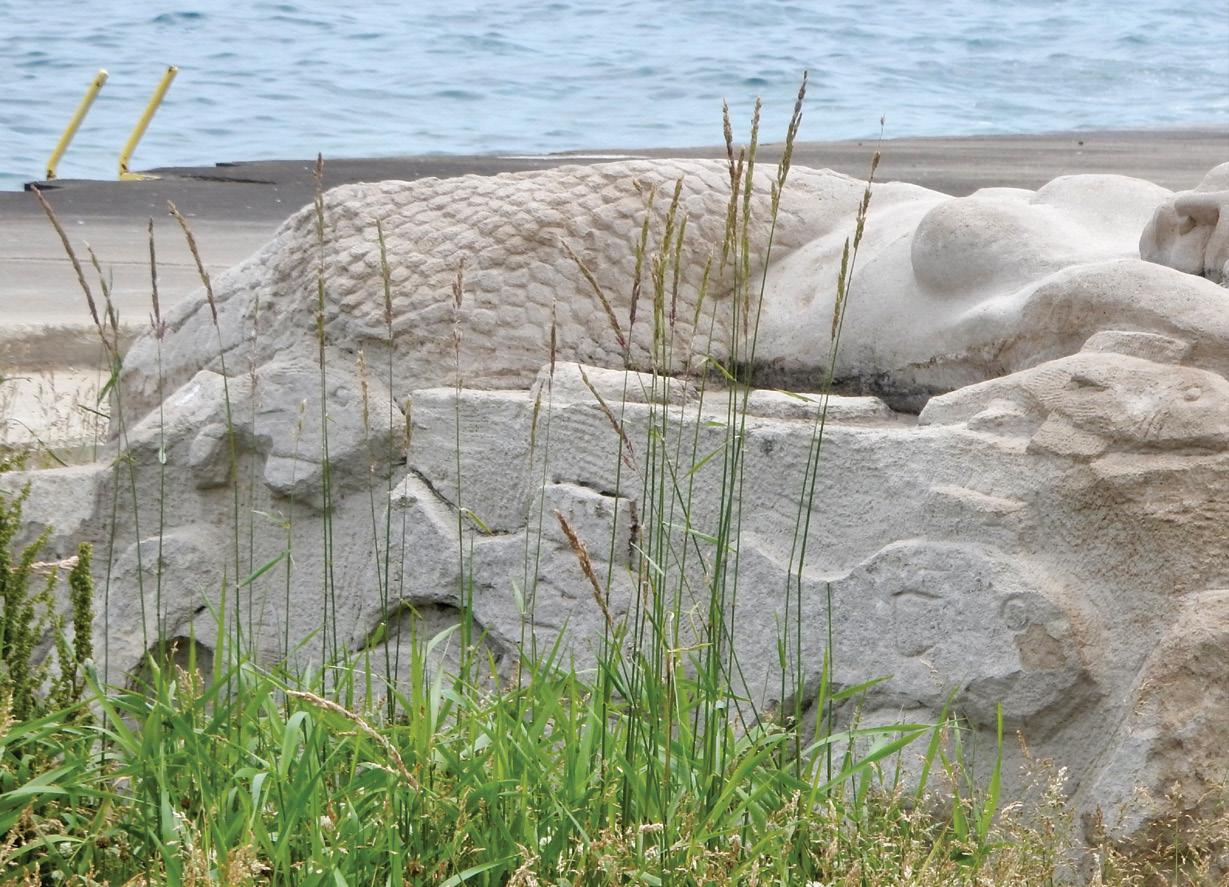
Some of the blocks remain in place, but the rocks where Villarreal and friends carved their figure were removed as part of a shoreline protection project. Someone in the Park District liked the sculpture, however, and it is now resettled near Oakwood Beach on the city’s South Side.

For years, though, the mermaid’s creators were unidentified. It was only in 2000, when the Chicago Sun-Times newspaper wrote about the “mystery mermaid,” that they stepped up and went public. You could say that the mermaid, like many of Villarreal’s stone carvings—like many great stone carvings generally—is most of all about presence. His carvings, be they animal, human or mythical, all have a quality of being intensely there. They are as emphatic and articulate as Villarreal himself. That’s a good thing, as he counts on the art to speak for him.
“Now I might never reap the full rewards of my work, but my descendants will, my kids will, my greatgrandchildren. They're going to know that Roman Villarreal was a life. Most of the people that I know here, they were all hard-working men. But once they die, they’re gone. The difference with me is, I left a legacy. Now, no matter what happens, I could be dead a hundred years, but Roman Villarreal is going to live through his art, which is kind of like being like immortal."
Ultimately, he loves the freedom of being an artist, the beauty he creates and the beauty he sees all around him. “What's interesting about being an artist, you can go to the ugliest places in the world and you're always going to see the beauty.
“We're very fortunate that we walk in beauty.” Intuit will open an exhibition of Roman Villarreal's work in 2022.
27
Roman Villarreal sculpture near Lake Michigan. Photograph by William Swislow.
“We're very fortunate that we walk in beauty.”
WALKING IN BEAUTY
BUILDING A PIPELINE

OF FUTURE MUSEUM PROFESSIONALS
By Lindsey Wurz featuring Cielo Aguilera
This page: IntuiTeens managers Mayra Palafox, Paula Santos and Cielo Aguilera on an IntuiTeens excursion to see Joseph Yoakum: What I Saw at the Art Institute of Chicago
Opposite page: Cielo Aguilera at the IntuiTeens workshop with the Social Justice Sewing Academy
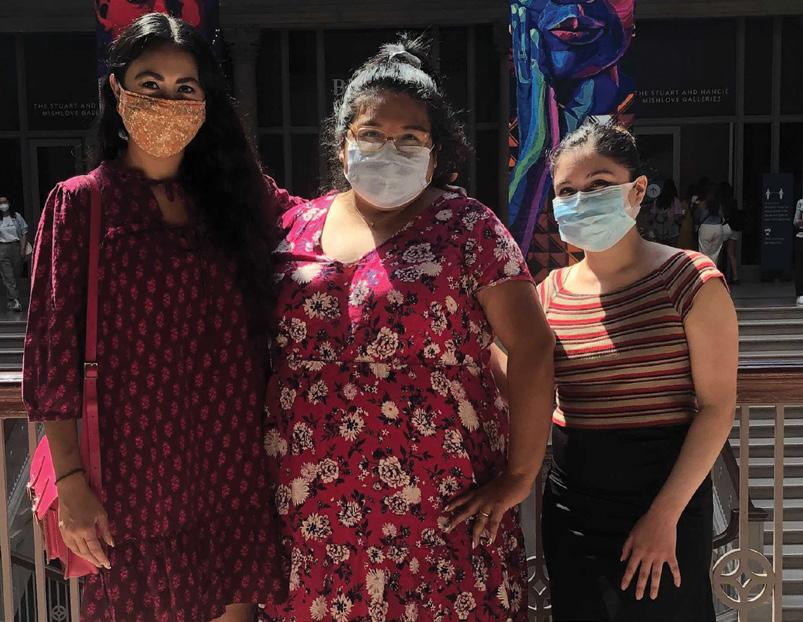
28 THE OUTSIDER
Recognizing the industry-wide need to offer paid positions to undergraduate and graduate students and students of color, Intuit in 2021 launched the Emerging Museum Professional Fellowship—initially the Summer Fellowship—in June with funding from the Field Foundation. Intuit designed the Fellowship for undergraduate and graduate students of color attending school in Chicago with backgrounds that have traditionally been underrepresented in the industry. The museum field is no stranger to unpaid internships, and neither is Intuit. The museum has long offered unpaid internships
and depends on the support of its volunteers. However, unpaid internships can act as a barrier to students who do not have the resources to offer their labor without compensation. Paid opportunities like the IntuiTeens summer internship and, now, the Emerging Museum Professional Fellowship open doors for students interested in advancing their career in the arts.
Throughout the eight-week program, the Fellow is introduced to all facets of museum work, including curation, collections, education, marketing, development and executive leadership. They work closely with senior managers and contribute to meaningful projects that advance the institution, while learning about and discussing with staff contemporary issues in the museum field. Those eligible to apply for the position are undergraduate and graduate students of color enrolled in city, community or state colleges with an interest in pursuing a career in the arts. Paula Santos, senior manager of learning and engagement, designed the fellowship to be available to all eligible students and, thus, developed a program agenda to accommodate remote work for those who were unable to commute to the museum.
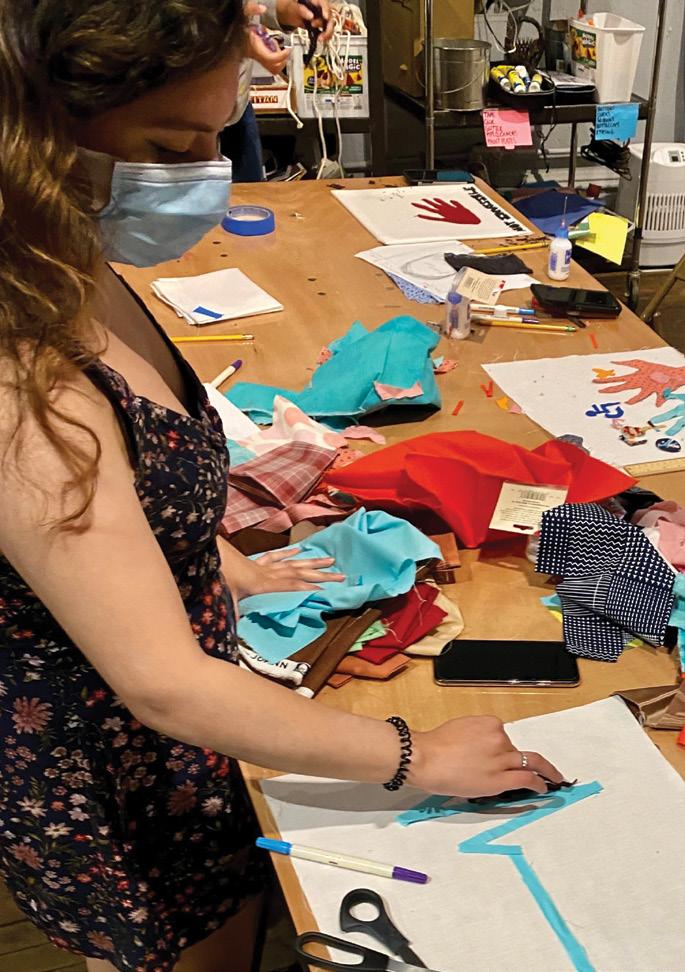
29
“I think sometimes we, as people of color, feel that we don’t really belong. It’s hard to imagine yourself in these kinds of spaces because your family is not in them, and you don’t see people like yourself…very often. I was able to see myself, afterwards, as someone who works in a museum given what I was able to do.”
–Cielo Aguilera
BUILDING A
PROFESSIONALS
PIPELINE OF FUTURE MUSEUM
The pool of applicants included students studying a range of subjects, including art education, English and museum studies. Among them was Cielo Aguilera, an emerging art educator who recently graduated from Morton College with her associate’s degree in fine arts. Aguilera, who identifies as Mexican American, is now at the University of Illinois Urbana-Champaign completing her bachelor’s degree in art education. She discovered the Fellowship when searching for opportunities to get involved with her artistic and creative side. Aguilera had worked as a pharmacy technician throughout her time at Morton College and sought opportunities that more closely aligned with her passion for education.
“I came across a list of fellowships, and Intuit came up. I never heard of Intuit, and I started looking into the website and became really interested right off the bat,” said Aguilera. “I saw how…it’s very focused on education. I saw not only the fellowship but the Teacher Fellowship Program, as well, and the mission statement really drew me in.”
The museum’s mission—to celebrate the power of outsider art—is grounded in the ethos that powerful art can be found in unexpected places and made by unexpected creators.
When researching Intuit, its mission and its programs, Aguilera found the museum welcoming: “[Intuit] wanted Black, Indigenous, people of color in the museum space and, for me, I felt like, ‘Okay, this is a space that I can feel comfortable in.’”
Santos selected Aguilera for the inaugural fellowship, noting her past experiences in publicfacing roles, her interest in art and museum education, her goals for the fellowship, and her goals for her future career in the arts.
Throughout her tenure at Intuit, Aguilera focused primarily on education, though she still participated in staff meetings and professional development opportunities in which she gleaned insights into the museum’s departments. Aguilera

Installation views of Emery Blagdon’s Healing Machines in the Trauma and Loss, Reflection and Hope exhibition (May 28–November 28, 2021), Intuit: The Center for Intuitive and Outsider Art
Photograph by Cheri Eisenberg
shared that, although she did not work closely with the development team, she learned a lot about how museums are funded—through donations, grants and earned revenue.
Her education background in fine arts, professional interests in museum education, and past volunteer experiences as an arts educator at Prairieview-Ogden South Elementary School and the Ryan Learning Center at the Art Institute of Chicago proved to be invaluable as she supported many of the museum’s educational initiatives. Aguilera joined Santos and museum educator Mayra Palafox as a facilitator for the IntuiTeens, a summer youth internship program dedicated to fostering intuitive creativity and leadership skills in Chicago teenagers.
“I took a lot away from both of their teaching styles,” Aguilera commented. From Palafox’s teaching in particular, Aguilera shared: “I learned that it’s okay if the students don’t respond right away; it’s okay to give that space and give them that time to think. They will eventually come around…they’ll be able to develop their own answer and feel more comfortable.”
Aguilera’s facilitation of the IntuiTeens program was the first time she led teenagers, and she spoke to how they invested themselves in the work. She noted “how [the teens are] thinking about museum spaces and the impact it has on them and the changes they want to see…is insightful for museums.” She observed of the IntuiTeens: “It is somewhere you can gain knowledge and experience.”
Aguilera supported the museum in the production of three virtual field trips, spotlighting pieces in the museum’s collection by the artists Mr. Imagination, Judith Scott and Emery
30 THE OUTSIDER
Blagdon. Furthermore, she led a virtual Art After Work in which she shared her research on the art and life of Emery Blagdon.
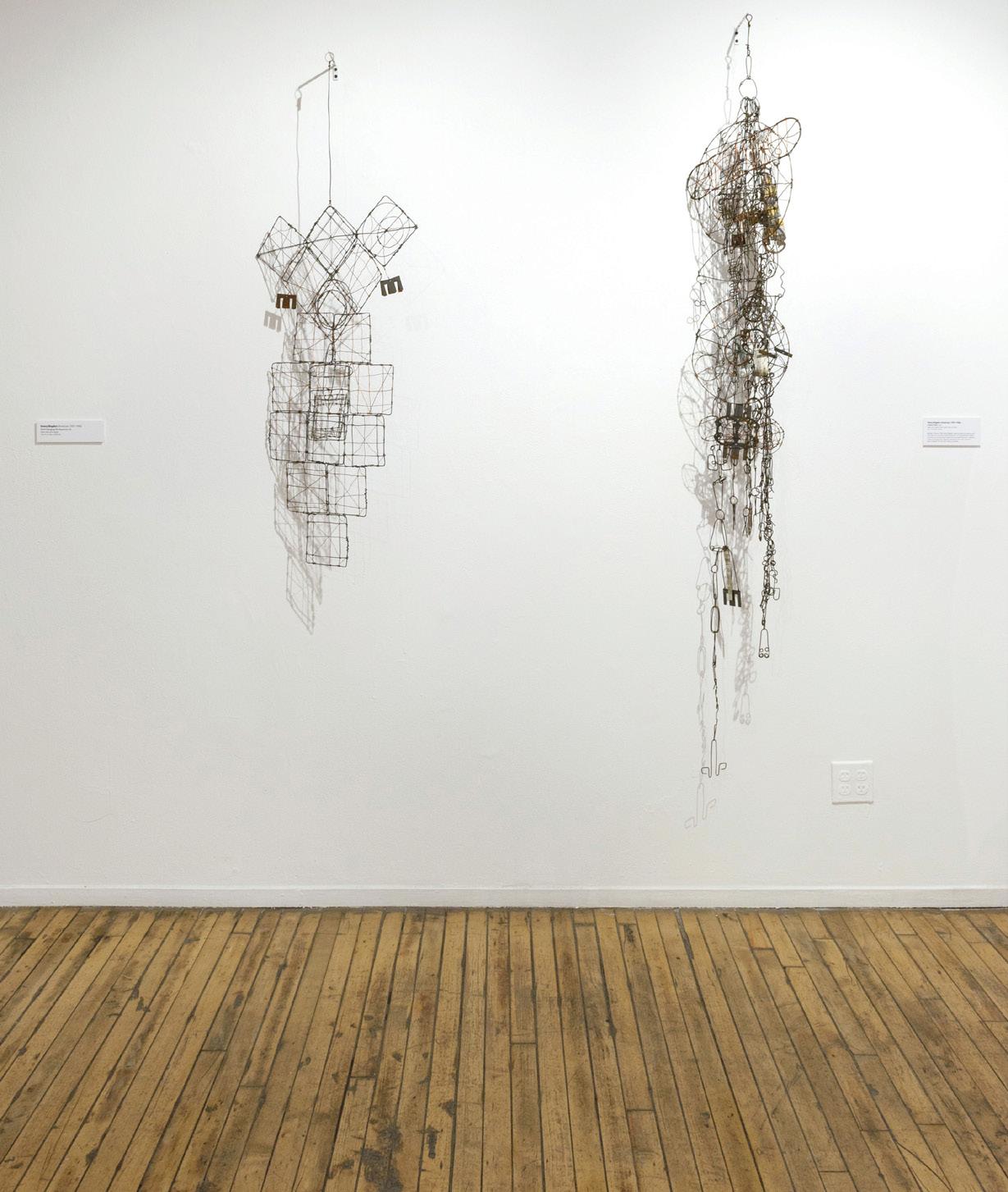
“I was mind blown by how much [Blagdon] dedicated his life to this project and…created this world. I was drawn to him because he was thinking [about] how we’re connected to energy, and he was drawn to the earth and the earth has these restorative and curative powers,” Aguilera said. “He was taking healing from a different perspective, which is trying to immerse yourself into both the physical things around you, and the energy that those things possess, and your connection to your environment and your space.”
In reflection, Aguilera spoke to her favorite moments at Intuit and her takeaways from the fellowship. In addition to the environment of collaboration, Aguilera identified her main
takeaway as seeing herself as a museum professional in the future. “Intuit helped me see parts of me that I wasn’t able to see; it diminished those doubts that I had about what I was doing. It further solidified the path that I am taking, and now I see that there’s a whole world I want to explore that Intuit has opened me up to.”
Aguilera will complete her art education studies at the University of Illinois Urbana-Champaign in the fall of 2022, after which she is open to exploring her next steps. She wants to teach in schools and is interested in pursuing a master’s degree in museum studies. Aguilera hopes to someday own a studio in her hometown of Cicero, Ill. As for Intuit, the museum will begin recruitment for the next cycle in the spring of 2022.
31
BUILDING A PIPELINE OF FUTURE MUSEUM PROFESSIONALS 31
BOOK REVIEWS
To the long list of reasons to resent the pandemic beyond death, sickness and unemployment, of course, we can add missing the opportunity to see Elijah Pierce’s carvings in person at Philadelphia’s Barnes Foundation.
The retrospective ran from September 2020 to January 2021 and included more than 100 works. But pandemic era travel restrictions prevented even ardent admirers from making the pilgrimage to Philadelphia. No matter how impressive the catalog, the master carver’s reliefs and sculptures really need to be seen in person to be fully appreciated. There simply is no way that photos can do them justice. And this book does have fine photos, well shot and
Photo / Elijah Pierce’s America, edited by Nancy Ireson and Zoé Whitley, with contributions by Sampada Aranke, Theaster Gates and Michael D. Hall. The Barnes Foundation, Philadelphia, in association with Paul Holberton Publishing, London, distributed by the University of Chicago Press, 208 pages, 120 color plates, 2020. ISBN: 9781911300878. Hardcover, $50

ELIJAH PIERCE’S AMERICA
generously sized. So, in the spirit of makedo, it’s a delight to see this work, and it’s great to have a record of this important exhibit to sit alongside the catalog for the 1992 Columbus Museum of Art blockbuster Elijah Pierce Woodcarver.
The Barnes show isn’t as big, but it includes some pieces that were not in the earlier exhibit, including a black Popeye and a great autobiographical relief of Pierce fleeing a Mississippi lynch mob. The earlier catalog boasts more scholarly depth than this one, but the new volume includes new generations of insights in its essays and a number of fine historical photographs of the artist.
The complexity of Pierce’s imagination comes through clearly. Of course, the creations of any artist who does not participate in the twisting and turning discourses of contemporary art may seem simple by comparison; however, the absence of that arcane conversation does not make the work simple.
Essayist Zoé Whitley takes appropriate aim at the cliché that “simple” is a hallmark of art by self-taught creators. “The apparent simplicity of his compositions belies a host of intertwined personal and collective references, legible to those who seek them,” she writes.
As with Bill Traylor, there is a tendency to simply not see what one does not comprehend.
32 THE OUTSIDER
In this admirably concise volume, Leisa Rundquist works diligently to normalize Henry Darger.

That seems like fair play considering how he’s been pathologized. Being a working-class self-taught artist and a loner made him vulnerable to whatever excesses of interpretation anyone wanted to throw at him.
THE POWER AND FLUIDITY OF GIRLHOOD IN HENRY DARGER’S ART
The eccentric and sometimes extreme nature of his art was a contributing factor. But, in effect, Darger remained a victim of the same epithet applied to him in his youth: “Crazy.”
Rundquist makes the broad point that much of what is so disturbing and befuddling in Darger’s work is a function of the intensity of feeling that he struggled to communicate—an intensity reflected in his religious passion, his devotion to his enormous creative project and his own personality (characterized, as he himself wrote, by great bouts of anger and frustration).
Photo / The Power and Fluidity of Girlhood
in Henry Darger’s Art, by Leisa Rundquist, Routledge, New York, 126 pages, 13 b/w Illustrations, 2021. ISBN: 9781138314559. Hardcover, $59.95
She drills deeper, of course. And the power of this book is in her close analysis of Darger’s sources and culture, especially the specific strands of influence from his devotion to Roman Catholicism. She makes the case that Darger’s obsessive treatment of little girls, including the naked girls and, especially, the notorious naked girls with penises, might have less to do with pathology and perversion and more with religion. The church has a long tradition of gender-bending saints like Joan of Arc, and Darger was almost certainly aware of them.
33
BOOK REVIEWS | ELIJAH PIERCE'S AMERICA / THE POWER AND FLUIDITY OF GIRLHOOD IN HENRY DARGER'S ART
BOOK REVIEWS
In that tradition, she writes, “becoming male marks the transcendence of gendered differences and thus, access to holiness.” The argument is not watertight, but it’s plausible, and it explains Darger’s imagery more effectively than many earlier, even more speculative and far more sensationalized accounts.
She also makes a convincing case that Darger’s treatment of little girls reflected common attitudes toward children in his time, up to and including the violent scenes that are a source of major discomfort for audiences today. They are excessive by any standard, but that doesn’t mean they are predatory or simply gratuitous.
“Modeling his little heroines after a bevy of rebellious, orphaned girls and virtuous female martyrs, Darger understood girlhood in his story as a journey of suffering and self-abnegation,” a kind of journey hardly unique to Darger’s imagination, Rundquist points out.
Rundquist is not alone in this re-imagining of Darger. She draws on the work of Michael Moon and Mary Trent, among others who have explored alternatives to psychiatric explanations of Darger and his work.
None of this says we should find that work comfortable—comfort was clearly not his intention. Even the moments of sweetness, of which there are many, to a great extent function as intensifiers for the moments of horror. “Seemingly powerless, the image of the cute little girl exudes a powerful aesthetic that manipulates the artist and viewer, alike,” Rundquist writes.
“Visualizing spiritual properties through the flesh of his little girl figure, a diminutive female, Darger raises the stakes to higher levels of sacredness and sentimentality as she becomes the ultimate site for suffering and Christian love…
“Extreme crucifixions, disembowelments, and gore become necessary in his quest to articulate the intensity of spiritual release.”
She shows just how much the work of this “outsider” was influenced by the culture in which he was immersed. It’s a reminder that while the term outsider can accurately reflect an artist’s position with regard to the academic art world, it is and almost always has been a misnomer when intended to mean isolation from culture as a whole.
Perhaps we should consider the extent to which we resent Darger for so effectively drawing us into this horrific drama. It’s easier when we can maintain a comforting distance between ourselves and the eccentric and sometimes disturbing messages of artists like Howard Finster, Royal Robertson and Jesse Howard. Part of Darger’s particular power is in how he still succeeds in collapsing that distance.
Photo / Prisoners’ Inventions, written and illustrated by Angelo in collaboration with Temporary Services. Half Letter Press, Chicago, 200 pages, 2020. ISBN: 9781732051423. Paperback, $20
34 THE OUTSIDER
She shows just how much the work of this “outsider” was influenced by the culture in which he was immersed.
If you’re looking for conventional prison art, this book isn’t the place. No warrior princesses or hands holding bars here. But if you are interested in the incredible creativity that incarceration can generate, this book is a good place to start.
In the first instance, there is the creativity of “Angelo,” the one-time California prison inmate who made the drawings featured here and who is responsible for most of the text. His sketches are both interesting and entertaining.
PRISIONERS’ INVENTIONS

But even more impressive are the ingenious inventions of the book’s title, all of them solutions to the privations of prison life that Angelo encountered or, in a few cases, at least heard about. They range from papier-mâché dice to a wall socket cigarette lighter to a toilet ice chest, each carefully diagrammed and described by Angelo.
The creative leaps involved in solving ordinary problems in an extraordinary environment give this work much of its oomph. But not every invention is functional. The chapter devoted to arts and crafts includes entries on tattooing and folded-paper picture frames, as well as how to create art supplies in the absence of conventional materials. Plus, there is a page of one of Angelo’s own masterpieces, a facsimile vintage Coca-Cola machine that the auto body shop instructor asked him to make for an open house.
It should be noted that this is one of the few art books that comes with a warning to its readers not to try any of these things at home.
The book is a collaboration of Angelo, who died in 2016, and the Chicago-based Temporary Services group, which has produced many publications and artistic collaborations over the last few decades. “Temporary Services does not observe a meaningful distinction between art and other forms of everyday creativity,” they say, and the works this book illustrates are great examples of that principle. BOOK REVIEWS | THE POWER AND FLUIDITY OF GIRLHOOD IN HENRY DARGER'S ART / PRISONERS' INVENTIONS
35
If you’re looking for conventional prison art, this book isn’t the place.
BOOK REVIEWS
Here’s another pandemic art disappointment—the grand exhibition of Rosie Lee Tompkins’ quilts at the Berkeley Art Museum and Pacific Film Archive (BAMPFA). Like Elijah Pierce’s carvings at the Barnes Foundation, these quilts clearly need to be experienced in person to get a true sense of their scale and material impact.
Tompkins is widely praised as the greatest quilter of her time, certainly up there with the women of Gees Bend when it comes to imagination and visual skill. Also, like them, she is in the top ranks of 20th-century abstractionists, and her work has escaped the cul-de-sacs of craft and self-taught art. And, again, like the women of Gees Bend, that’s at least partly because of the recognition and promotion of a devoted patron, in this case, Eli Leon, who helped transition her quilts from the swap meet to the Whitney Museum of American Art.
ROSIE LEE TOMPKINS
Leon collected quilts in quantity, Tompkins’ included, and he ultimately gifted nearly 3,000 to BAMPFA. The museum now owns 500 of Tompkins’ quilts and included 70 of them in this retrospective.
The show opened Feb. 19, 2020, but the physical run was cut short by the COVID-19 pandemic. The museum converted it to a virtual exhibit running through July 18, 2021, including an hour-long virtual tour. It became once again accessible physically in May 2021.
The online resources, together with the printed catalog, provide a fine survey of her work, whose nuances and imaginative leaps are astounding even in the absence of an in-person visit, with the catalog’s essays helping to draw attention to many of those nuances and leaps.
Photo / Rosie Lee Tompkins: A Retrospective, by Elaine Y. Yau, Lawrence Rinder and Horace Ballard. University of California, Berkeley Art Museum and Pacific Film Archive, 175 pages 2020. ISBN: 9780983881384. Paperback, $39.95
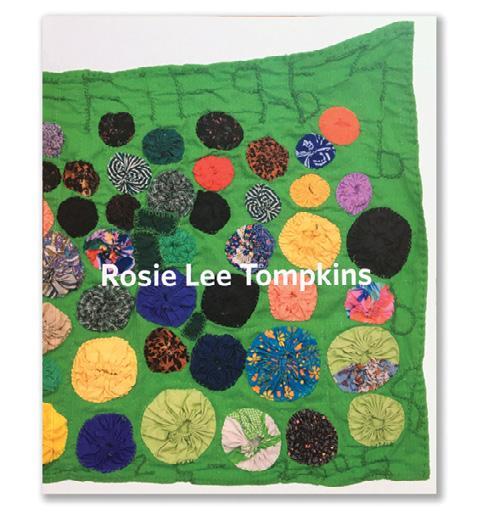
36 THE OUTSIDER
LOUD, NAKED, & IN THREE COLORS
This volume presents a nicely balanced combination of tattoo art and tattoo lore. The book by its own account “looks beyond the connoisseurship of historical flash art” to tell the story of the tattooers, “an often transient, marginalized group,” which it does effectively, in the form of one family.
The 70 pages devoted to flash art aren’t bad, but the most exceptional part of the book is the intimate story it tells about the Liberty family, a father and sons who were Boston’s pre-eminent tattoo artists in the mid-20th century.
Edward “Dad” Liberty was creating tattoos as early as 1915 and was plying the craft in Boston no later than early 1919. In later years, sons Frank, Harold and Ted all followed him into the trade.
The Libertys hailed from nearby Lowell, Mass., and Harold Liberty, one of the sons, maintained the tradition even after Massachusetts outlawed tattoo shops in 1962. Harold relocated to Salem, N.H., just over the state line and less than an hour from Boston.
The family, whose descendants’ cooperation enriched this book, operated bowling alleys and shooting galleries before taking up the needle. Tattooing seems like it was a natural progression given the family’s involvement with entertainment for the masses.
The book features lots of photos and details about the colorful places the Libertys worked, especially Scollay Square, Boston’s down-market, long-gone and much-lamented entertainment district. It was removed wholesale in the 1960s to make way for the Government Center urban renewal project, widely reviled although beloved among devotees of brutalist architecture.
BOOK REVIEWS | ROSIE LEE TOMPKINS / LOUD, NAKED, & IN THREE COLORS

37
BOOK REVIEWS
The photos include vintage tattoo shop signs and storefronts as well as pictures of “Dad” Liberty and one of his masterpieces, the wall-to-wall tattoos he did for Cassius Church—an eagle, horseshoes, a Madonna and much more.
The book is, of course, enriched by many pages of tattoo designs. Most of the flash in the book was not created by a Liberty, but many were owned and used by a Liberty. The authors note that the tattoo world was characterized by a high degree of sharing, at least across different geographies. And the designs that are attributed to a Liberty are as interesting and often as accomplished as the rest.
As collectors of flash have known for years, these sheets of prospective tattoo designs can be dense with creativity. They also are occasionally dense with offense. The authors point out that some “designs tend to reflect the casual sexism, racial stereotyping, and clumsy sentimentality that have permeated American popular culture of generations.”
Nonetheless, the 700+ newly discovered designs painted by the Libertys, Ben Corday, Frank Howard, Ed Smith and others represent a great catalog of a prime 20th-century folk art.
And if, like me, you’re not a big fan of tattoos themselves, it’s worth noting that the Libertys did a brisk trade in tattoo removal.
Photo / Loud, Naked, & In Three Colors: The Liberty Boys & The History of Tattooing in Boston, by Margaret Hodges and Derin Bray. Rake House, Portsmouth, N.H., 160 pages, 2020. ISBN: 9780578758404. Hardcover, $70
38 THE OUTSIDER
As collectors of flash have known for years, these sheets of prospective tattoo designs can be dense with creativity. They also are occasionally dense with offense.
William Swislow
PROGRAMS

Art After Work is a free series of facilitated art-making workshops inspired by outsider and self-taught art and artists. Intuit hosts Art After Work on the third Thursday of each month.
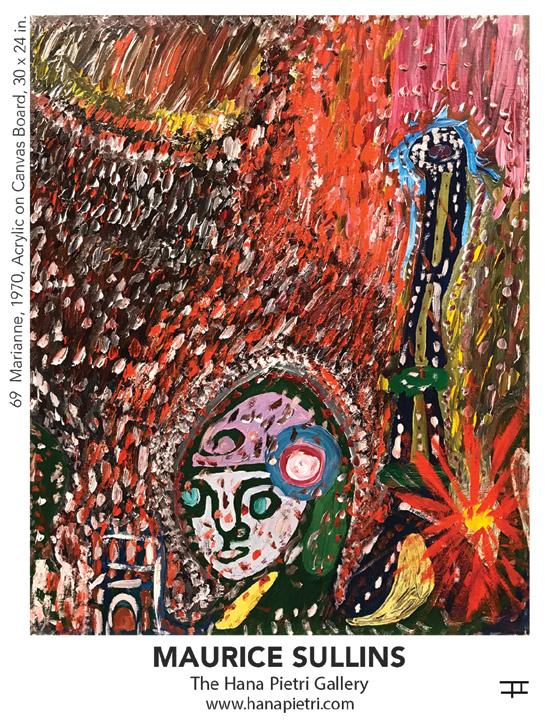
One Night Stand is a free series of art talks that focus on individual works of art from the museum’s collections and exhibitions. Intuit hosts One Night Stand on the last Wednesday of each month.
In dialogue with Intuit, a contemporary artist discusses their background, their art-making and inspiration, and the evolution of their career at an Artist Talk, which concludes with an audience Q&A.
Intuit members are invited to a series of virtual private Collection Tours. Each event includes a screening of a collector’s home tour, followed by questions and answers with the collector about their collecting journey.
39
BOOK REVIEWS | LOUD, NAKED, & IN THREE COLORS

BOARD OF DIRECTORS
Tracy Holmes, President
Patrick Blackburn
Richard Bowen
Tim Bruce
Robert Burnier
Cheri Eisenberg
Lewis Greenblatt Rob Grossett Scott Lang Rob Lentz
Bonnie McGrath César Montenegro Elizabeth Nelson
Benedicta Badia Nordenstahl Jan Petry
VIVIAN SOCIETY (LIFE TRUSTEES)
Kevin Cole
Ralph Concepcion
Susann Craig • Harriet Finkelstein
Marjorie Freed Carl Hammer
Eugenie Johnson Ann Nathan Bob Roth Judy Saslow Lisa Stone
STAFF
Debra Kerr, President and CEO
Alison Amick, Senior Manager of Exhibitions and Development, Chief Curator
Julie Blake, Special Projects and Merchandising Coordinator
William Deschler, Finance and Operations Manager
Claire Fassnacht, Development Manager
Tynnetta Qaiyim Phyllis Rabineau
Kevin Sampson
Twisha Shah-Brandenburg
Jerry Stefl
Michael Sullivan William Swislow David Syrek Stacy Wells Cleo Wilson Zachary Wirsum Adam Wolford Michelle Woods Dana Boutin, ex officio
STRATEGIC ADVISORY COUNCIL
Scott Lang, Chair Susan Baerwald Michelle Boone John Jerit Victor Keen John Maizels
Frank Maresca Douglas Robson Ashley Smither Langley Leslie Umberger
• Deceased
Tina Horton, Development Associate
Alexis Kindelan, Guest Services Associate
Charlie Miller, Guest Services Associate
Claire Renaud, Assistant Registrar
Paula Santos, Senior Manager of Learning and Engagement
YOUNG PROFESSIONALS BOARD
Dana Boutin, President
Sarah Anderson
Spencer Blaney Gabriella Bomben
Teddy Braziunas Wyatt Buescher
Jane Castro
Gabrielle Christiansen Sofia Coulson
Marilyn Creswell
Ben Fisher
Katherine Gorman Shawn Grenald
Emma Kearney
Catherine LaMendola Katherine Lelek Lail Marmor Jen Moss
Emily van der Haarten Jessica Wain Annaleigh Wetzel Joshua Willis
Riley Yaxley Fabiola Yep Leah Zuberer
LEADERSHIP
Christina Stavros, Registrar and Facilities Coordinator
Larry Tate, Guest Services Associate
Joshua Willis, Guest Services Associate
Lindsey Wurz, Marketing and Communications Coordinator
41
LEADERSHIP
Thank you, members and donors, for bringing to life profound outsider art exhibitions and programs to benefit thousands of students, teachers and audience members.
$50,000+
Robert A. Roth
Terra Foundation for American Art
$25,000–$49,999
Alphawood Foundation
Chicago Department of Cultural Affairs and Special Events
Eugenie Johnson
MacArthur Arts and Culture Fund at Prince Jan Petry Polk Bros Foundation
$10,000–$24,999
Anonymous
Art Dealers Association of America Foundation
Crown Family Philanthropies
Gaylord and Dorothy Donnelley Foundation
Janet and Craig Duchossois
The Duchossois Family Foundation
Illinois Arts Council Agency
Ashley and Mike Joyce
Jeanne Ruddy and Victor F. Keen
Debra Kerr and Steven D. Thompson
Angie Mills
Tom Yoder and Kathleen Carl
$1,000–$4,999
Paula and Gordon Addington
Judith and Patrick Blackburn
Edward Blanchard and Leslie Tcheyan
Richard Bowen
Wallace Bowling and Douglas Dawson
John Cain Cindy Coleman
The Field Foundation
Harriet Finkelstein
Marjorie Freed Nancy Gerrie
Jennifer and Scott Gordon
Nancy Grant and Steven Gray
Jean and Lewis Greenblatt
Moira Collins Griffin and Andrew Griffin
Robert Grossett and Christopher LaMorte
Kathy and Charles Harper
William Hinchliff
Tracy Holmes
Dorn Jensen
John Jerit
Kelly Jones
Marguerite Juliusson and David Montagano
Just Folk Gallery James Kaufmann
Kate Kirley
Ruth DeYoung Kohler Foundation
Ashley and Curt Langley
Rob Lentz and MK Victorson
Kathi and Tom Lind
Frank Maresca
Michael McCluggage and Stella Lee Bonnie and Molly McGrath
César Montenegro
Sandra and Michael Perlow
Anthony Petullo
Tynnetta Qaiyim
Phyllis Rabineau and John Alderson
Brooke and Patrick Raymond Douglas Robson
Leisa Rundquist and Julia Hodges
Ellen and Richard Sandor
JoAnn Seagren and Scott Lang
Twisha Shah-Brandenburg and Thomas Brandenburg
Eugenie Shields
Susan Manning Silverstein and Rob Silverstein
Toni Smith
Judy and Jerry Stefl
Kimberly and Andy Stephens
Michael Sullivan
William Swislow and Janet Franz
David Syrek and David Csicsko
Minna and Charles Taylor
Dale Taylor and Angela Lustig
David Walega
Stacy Wells and Rick Farrell
West Town Chicago Chamber of Commerce
Janet Williams and Ralph Concepcion
Cleo Wilson
Zachary Wirsum and Patricia Courson Michelle Woods Janice and Erich Wurz
Contact Claire Fassnacht, development manager, at (312) 624-8000 or claire@art.org.
42 THE OUTSIDER
SUPPORT
NOVEMBER 2020 – OCTOBER 2021 HAVE YOU ALREADY INCLUDED INTUIT IN YOUR WILL, TRUST OR IRA? Planned gifts of assets, cash, art and more to Intuit help to inspire future audiences and ensure access to the museum’s exhibitions and programs. Let us know about your plans and receive Legacy Society benefits or contact us to learn about planned giving with Intuit.
CIELO AGUILERA LEISA RUNDQUIST
Cielo Aguilera is a Chicagoborn artist studying K-12 art education at the University of Illinois Urbana-Champaign. She is an alumna of Morton College in Cicero, Ill., where she earned her Associate in Fine Arts. Before joining Intuit as its first Summer Fellow, Cielo led online art lessons for third graders and volunteered at the Art Institute of Chicago at the Ryan Learning Center. Currently, she is doing her preservice art teaching with Stratton Elementary in Champaign, Ill. Her teaching philosophy is centered around educational equity, diversity and inclusion.
MICHAEL BONESTEEL

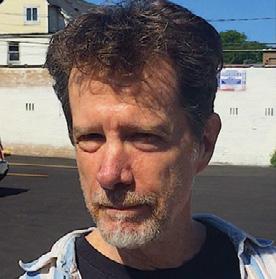
Michael Bonesteel is an independent scholar, curator and contributing editor to Raw Vision. He is the author of Henry Darger: Art and Selected Writings (Rizzoli International, 2000) and was an art critic for Art in America and Artforum magazines (New York), as well as managing editor of the New Art Examiner (Chicago). His writing will appear in Lisa Slominski’s forthcoming book Nonconformers (Quarto Publishing).
Leisa Rundquist is a professor of art history at the University of North Carolina Asheville. She is the author of The Power and Fluidity of Girlhood in Henry Darger’s Art (2021) and guest curator of Betwixt and Between: Henry Darger’s Vivian Girls (Intuit, 2017). She made contributions to the exhibition series Henry Darger: The Room Revealed (Intuit, 2021). Rundquist is currently working on an article for the International Panorama Council Journal regarding panoramic landscapes in Darger’s art.
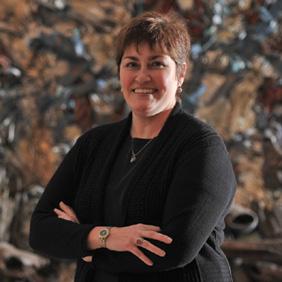
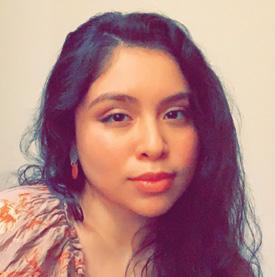
Bill Swislow is an Intuit board member and frequent contributor to The Outsider He is a digital business consultant, a writer and the operator of www.interestingideas.com, a website dedicated to vernacular culture, outsider art and oddball ideas.
LINDSEY WURZ
Lindsey Wurz is the marketing and communications coordinator at Intuit as well as managing editor of The Outsider.
SPECIAL THANKS:
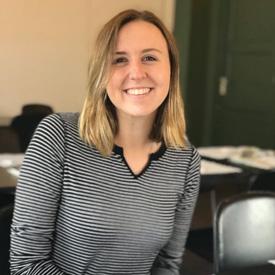
43
CONTRIBUTORS
SUPPORT / CONTRIBUTORS
Jennifer Bennett Walker, Design Elizabeth Nelson, Design Management
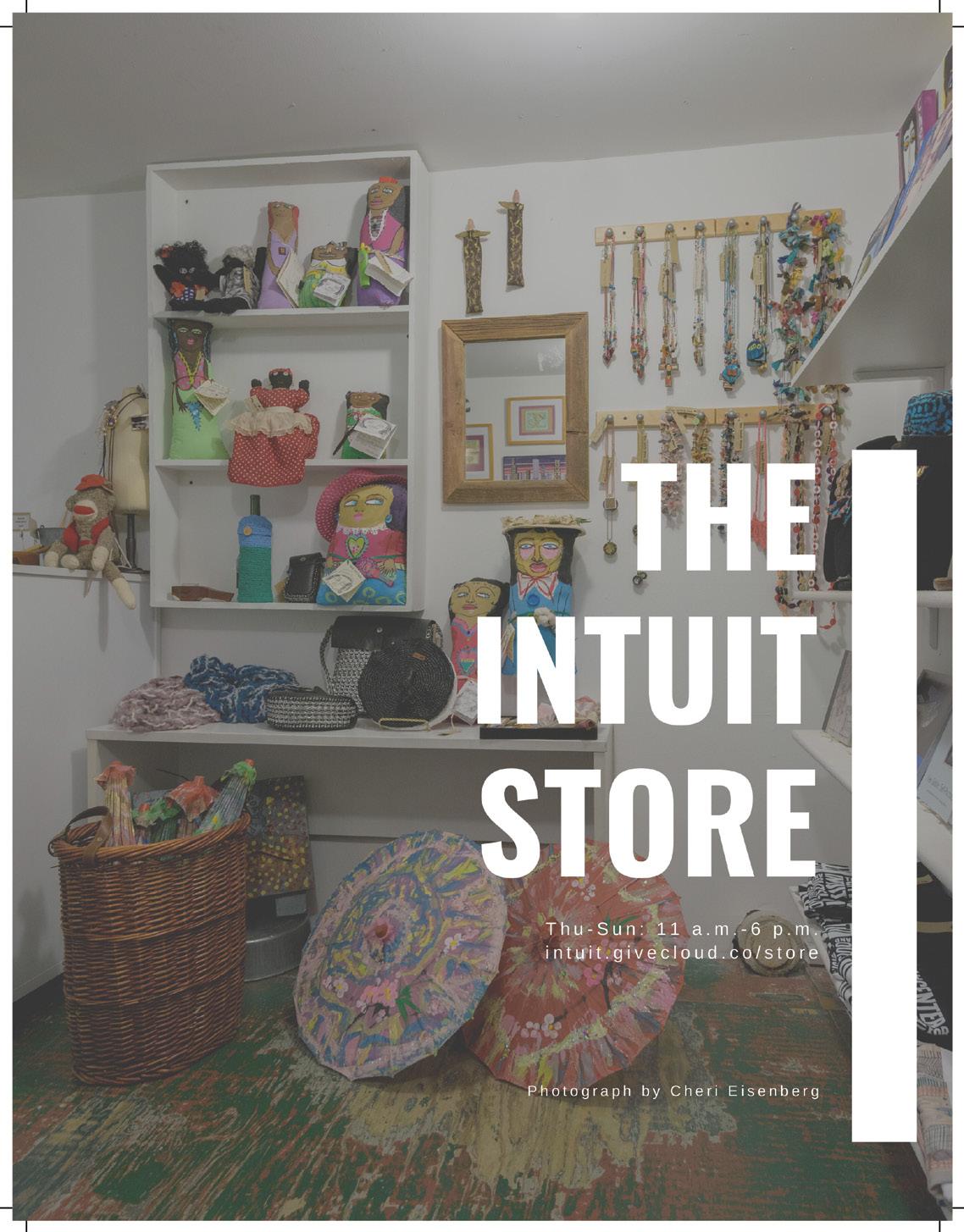
44 THE OUTSIDER (312) 624-9487 www.art.org @intuitartcenter 756 N. Milwaukee Avenue Chicago, IL 60642 intuit@art.org










 Installation views of Henry Darger: The Room Revealed exhibition series (June 11 –November 28, 2021), Intuit: The Center for Intuitive and Outsider Art
Photographs by Cheri Eisenberg
Installation view of the Henry Darger Room Collection at Intuit: The Center for Intuitive and Outsider Art.
Photo © John Faier
Installation views of Henry Darger: The Room Revealed exhibition series (June 11 –November 28, 2021), Intuit: The Center for Intuitive and Outsider Art
Photographs by Cheri Eisenberg
Installation view of the Henry Darger Room Collection at Intuit: The Center for Intuitive and Outsider Art.
Photo © John Faier
















 BY LEISA RUNDQUIST
BY LEISA RUNDQUIST






 By William Swislow
By William Swislow


























